| |
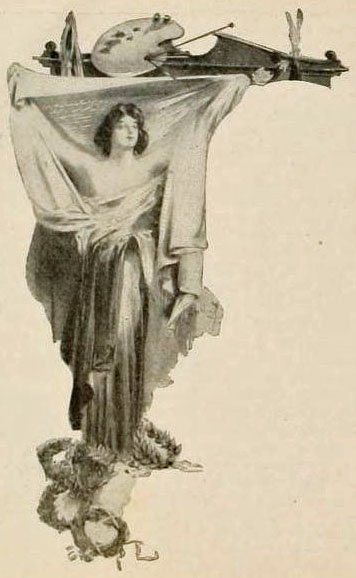 |
RIVER TO RIVER ROAD
ASSOCIATION

| OFFICERS |
|---|
| |
| W. E. WEEKS, Chairman | Guthrie Center |
| J. W. EICHINGER, Secretary |
Des Moines, Polk County |
| | | EXECUTIVE COMMITTEEMEN |
|---|
| |
| DICK R. LANE | Davenport, Scott County |
| FRANK C. CARSON | Iowa City, Johnson County |
| C. M. BEEM | Marengo, Iowa County |
| B. J. RICKER | Grinnell, Poweshiek County |
| L. D. BAUM | Newton, Jasper County |
| W. E. MOYER | Des Moines, Polk County |
| M. W. THORNBURG | Redfield, Dallas County |
| J. W. FOSTER | Guthrie Center, Guthrie County |
| EDWIN DELAHOYDE | Exira, Auduban County |
| DR. F. W. PORTERFILED | Atlantic, Cass County |
| CHARLES R. HANAN | Council Bluffs, Pottawattamie Co. |
|
| 6 |
 |
River to River Road
|
|
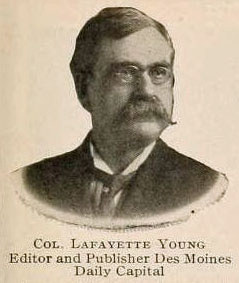 Iowa’s
River to River Road is a dragged road from Davenport to Council Bluffs.
It crosses Iowa in almost a straight line from river to river along the
main route of all transcontinental travel. The road is 380 miles long.
It passes through Des Moines, capital of the state, a dozen bright,
hustling, little cities, ranging from 5,000 to 25,000 inhabitants and
some thirty small towns and villages. There are over 600 farm houses
fronting on the road and more than 1,500 that stand within one mile of
the road. Iowa’s
River to River Road is a dragged road from Davenport to Council Bluffs.
It crosses Iowa in almost a straight line from river to river along the
main route of all transcontinental travel. The road is 380 miles long.
It passes through Des Moines, capital of the state, a dozen bright,
hustling, little cities, ranging from 5,000 to 25,000 inhabitants and
some thirty small towns and villages. There are over 600 farm houses
fronting on the road and more than 1,500 that stand within one mile of
the road.
The River to River Road has been improved and is
being maintained by the River to River Association. This is an
organization comprising business and professional men living along the
road in each
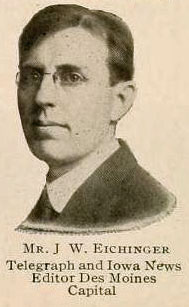 of
the twelve counties through which it passes. There is an executive
committeeman in each county who has full charge of everything pertaining
to the road in his territory. Headquarters are maintained with the
association secretary in charge in the office of The Des Moines Capital. of
the twelve counties through which it passes. There is an executive
committeeman in each county who has full charge of everything pertaining
to the road in his territory. Headquarters are maintained with the
association secretary in charge in the office of The Des Moines Capital.
The River to River Road is a newspaper enterprise
backed up by the co-operation of all the people living along the road.
It was planned and carried to completion as an object lesson in road
making and as one phase of a general good roads campaign conducted
through the columns of The Capital by J. W. Eichinger, good roads editor
of The Capital. Col. Lafayette Young, editor and publisher of The
Capital, first broached the idea of a River to River Road. He urged it
as a demonstration of what road dragging methods could do the highways
of Iowa under present road legislation and levies and with the existing
township and county road making organizations.
During the fall of 1909 Iowa’s highways were the
worst in many years. The bottom simply dropped out all over the state.
Rural routes were discontinued, some times for weeks in succession. It
became apparent more than ever before that the one greatest need in Iowa
was improved highways. No one in the state could realize this so well as
the state news editor of a great state wide paper. It was at this time
when the burden of all correspondence coming into the office of The
Capital was the condition of the public highways, that a campaign for
road improvement was determined upon. Through a chance...
|
| 7 |
 |
|
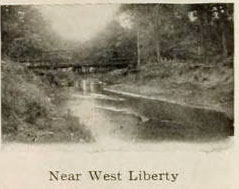 …
remark of William Wiseman, former City Editor of The Capital, the good
roads editor learned of Col. Young’s suggestion of a River to River
Road. This was seized upon as the concrete thing to be accomplished and
to be made the basis of the entire general campaign. The River to River
Road idea and the plan for having the road improved and maintained by
the co-operation of the people living along the road was sprung. The
plan was based on the road officers of an unbroken line of townships
from one side of the state to the other, improving and maintaining the
section of the road lying inside their township borders. The idea caught
on. The general good roads campaign caught on also. March 8 and 9, in
response to a call issued by Governor Carroll, 2,000 delegates gathered
in Des Moines in a general state convention and in response to a call
from the good roads editor of The Capital 200 delegates from the twelve
River to River Road counties gathered in a caucus on the River to River
Road. There was a hot fight over rival routes, but in the end the River
to River Road Association was organized. Live men were secured in each
county as executive committeemen. These men organized their counties,
and finally set to work upon the actual improving of the highway. Grades
were built up, wet places drained and hundreds of road drags set to
work. Within a short time a large portion of the road was under road
dragging contracts, in which farmers living along the road, agreed to
drag the highway after every rain and receive the state drag law, the
sum of fifty cents per mile traveled by the drag. …
remark of William Wiseman, former City Editor of The Capital, the good
roads editor learned of Col. Young’s suggestion of a River to River
Road. This was seized upon as the concrete thing to be accomplished and
to be made the basis of the entire general campaign. The River to River
Road idea and the plan for having the road improved and maintained by
the co-operation of the people living along the road was sprung. The
plan was based on the road officers of an unbroken line of townships
from one side of the state to the other, improving and maintaining the
section of the road lying inside their township borders. The idea caught
on. The general good roads campaign caught on also. March 8 and 9, in
response to a call issued by Governor Carroll, 2,000 delegates gathered
in Des Moines in a general state convention and in response to a call
from the good roads editor of The Capital 200 delegates from the twelve
River to River Road counties gathered in a caucus on the River to River
Road. There was a hot fight over rival routes, but in the end the River
to River Road Association was organized. Live men were secured in each
county as executive committeemen. These men organized their counties,
and finally set to work upon the actual improving of the highway. Grades
were built up, wet places drained and hundreds of road drags set to
work. Within a short time a large portion of the road was under road
dragging contracts, in which farmers living along the road, agreed to
drag the highway after every rain and receive the state drag law, the
sum of fifty cents per mile traveled by the drag.
|
| ~ J. W. Eichinger |
 |
| 8 |
 |
Davenport
|
|
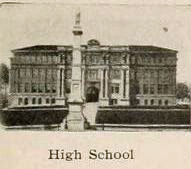 At
Davenport, which sits so majestically upon its hills overlooking the
noble stream which laves its shores, one very naturally, and very
properly, goes to Rock Island arsenal on the government island opposits
the great city which is spreading out over so much of the eastern part
of Scott County. It is from this island that one of the most extensive
of the world’s railway systems takes its name and over its tracks,
crossing the island, the heavy traffic of transcontinental transport and
travel is daily shunted back and forth with the speed of lightning. From
car windows millions have eagerly caught glimpses of the beauties of
this reservation, which, in the midst of the scenes of peace, is devoted
to the purposes of war. Here is the greatest ordnance manufacturing
establishment in the United States, destined, if wars shall not cease,
to be one of the greatest in the world. Here, too, is one of the finest
natural parks in existence, golf links that have been pronounced the
peer of any in the world, and old buildings and cemeteries, Union and
Confederate, which give a spot naturally charming a high historical
interest. The length of this island can be traversed in an auto over a
government road of macadam that gives one an idea of what the River to
River road itself may be in the course of time, if the present interest
is not allowed to subside and the present organization for improvement
is sedulously maintained. The arsenal road is road perfection, nothing
less. At
Davenport, which sits so majestically upon its hills overlooking the
noble stream which laves its shores, one very naturally, and very
properly, goes to Rock Island arsenal on the government island opposits
the great city which is spreading out over so much of the eastern part
of Scott County. It is from this island that one of the most extensive
of the world’s railway systems takes its name and over its tracks,
crossing the island, the heavy traffic of transcontinental transport and
travel is daily shunted back and forth with the speed of lightning. From
car windows millions have eagerly caught glimpses of the beauties of
this reservation, which, in the midst of the scenes of peace, is devoted
to the purposes of war. Here is the greatest ordnance manufacturing
establishment in the United States, destined, if wars shall not cease,
to be one of the greatest in the world. Here, too, is one of the finest
natural parks in existence, golf links that have been pronounced the
peer of any in the world, and old buildings and cemeteries, Union and
Confederate, which give a spot naturally charming a high historical
interest. The length of this island can be traversed in an auto over a
government road of macadam that gives one an idea of what the River to
River road itself may be in the course of time, if the present interest
is not allowed to subside and the present organization for improvement
is sedulously maintained. The arsenal road is road perfection, nothing
less.
Leaving the smooth going of this macadam and
returning by the plank roadway of the government’s great streel bridge,
erected under the engineering direction of Ralph Modjeska, son of Madame
Modjeska, the noble woman and gifted actress, whose recent death in
California left the world in
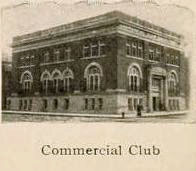 tears,
one honks down the asphalted streets of Davenport, assuredly one of the
most beautiful and one of the most interesting of Midwestern American
cities. Here, counting the cities of Rock Island and Moline, which find
their metropolitan center on the Iowa side, is a community very
compactly built, covering in fact hardly more than half of the area of
the city of Des Moines, and yet possessing a population of not less than
125,000 souls. The growth of each decade of late has been about 25,000
with a decided tendency to acceleration as the aggregate increases. It
is perfectly certain that there is to be at this point on the banks of
the Mississippi a two-state city of not less than a quarter of a million
people in the course of another generation. Always an important
distributing point for eastern Iowa and western Illinois, Davenport has
been growing great at the expense of its neighbors in the manufacturing
and wholesaling lines and has easily been able to hold its own in all
fields in … tears,
one honks down the asphalted streets of Davenport, assuredly one of the
most beautiful and one of the most interesting of Midwestern American
cities. Here, counting the cities of Rock Island and Moline, which find
their metropolitan center on the Iowa side, is a community very
compactly built, covering in fact hardly more than half of the area of
the city of Des Moines, and yet possessing a population of not less than
125,000 souls. The growth of each decade of late has been about 25,000
with a decided tendency to acceleration as the aggregate increases. It
is perfectly certain that there is to be at this point on the banks of
the Mississippi a two-state city of not less than a quarter of a million
people in the course of another generation. Always an important
distributing point for eastern Iowa and western Illinois, Davenport has
been growing great at the expense of its neighbors in the manufacturing
and wholesaling lines and has easily been able to hold its own in all
fields in …
|
| 9 |
 |
|
 …
the face of keen competition from Chicago, less than 200 miles away.
Through the activity and well directed efforts of its business men in
the associated capacity, it has cultivated a steadily enlarging field of
trade, until, in these days, wherever one goes in Iowa one meets the
Davenport traveling man carrying sample cases for Davenport houses and
extremely proud of it. Love of his city is the striking characteristic
of the Davenporter, and when one has seen his city and its surroundings
as one may easily do in an auto any fine day, one does not wonder at all
that he feels that way about it. Up at Bettendorf, which is an adjacent
suburb, there is one of the mammoth factories of the country in process
of erection and at the same time in operation day and night making steel
cars for the railways. It would take a book larger than this one merely
to enumerate the industries of Davenport. Besides it is more pleasant to
visit the parks and traverse the boulevards. …
the face of keen competition from Chicago, less than 200 miles away.
Through the activity and well directed efforts of its business men in
the associated capacity, it has cultivated a steadily enlarging field of
trade, until, in these days, wherever one goes in Iowa one meets the
Davenport traveling man carrying sample cases for Davenport houses and
extremely proud of it. Love of his city is the striking characteristic
of the Davenporter, and when one has seen his city and its surroundings
as one may easily do in an auto any fine day, one does not wonder at all
that he feels that way about it. Up at Bettendorf, which is an adjacent
suburb, there is one of the mammoth factories of the country in process
of erection and at the same time in operation day and night making steel
cars for the railways. It would take a book larger than this one merely
to enumerate the industries of Davenport. Besides it is more pleasant to
visit the parks and traverse the boulevards.
|
| Walcott
Walcott is situated a half mile off the River to River road, thirteen
miles from Davenport and is the first station on the Rock Island’s main
line west of that city. It is easily reached by a short detour from the
main highway and is the location of a well equipped and intelligently
conducted garage. Town and its surroundings lie on absolutely level
ground and the country in the vicinity is often referred to as some of
the best in the entire state. Streets of the town are partly macadamized
and being constantly improved. Also lawns and gardens are well kept and
the stranger is impressed with the note of neatness prevailing in the
community, which is largely a German one. A good bank offers
accommodations of its kind to the tourist, and the business houses and
hotels are of unusual excellence. The high tower of the water works may
be climbed and from the top, guarded by a railing, one may obtain a good
view of the surroundings. |
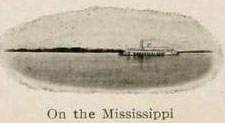 |
| 10 |
 |
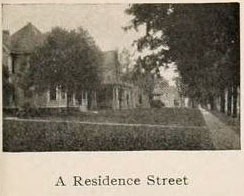 Durant
Durant is a typical town of this part of the state, a tidy little city
where it is pleasant to stop and where the inhabitants are agreeable and
helpful. One finds a hearty welcome here at any time of the day and has,
through the medium of the stores and repair shops, means of first aid to
the injured machine and resources in the way of needed supplies of all
sorts. Durant
Durant is a typical town of this part of the state, a tidy little city
where it is pleasant to stop and where the inhabitants are agreeable and
helpful. One finds a hearty welcome here at any time of the day and has,
through the medium of the stores and repair shops, means of first aid to
the injured machine and resources in the way of needed supplies of all
sorts.
Wilton Junction
Wilton Junction is a town of 1,200 inhabitants and is situated on the
main line of the Rock Island railroad. A branch runs from here to
Muscatine, connecting with the Kansas City division of the same system.
The town is known far and wide for its fine residences and public
improvements such as cement walks in every part of the corporation. The
mayor and city council are progressive and good water works and electric
light plant are municipally owned and operated with success and profit
to the taxpayers and consumers. The Warner Arc Light Company and the
Muscatine French Cheese Company are located here and ship their products
to all parts of the world. The Commercial club is active in getting such
industries and progressive in other ways. E. W. Clark is the president
of the organization and H. E. Nicolaus secretary. A. R. Whitmer is mayor
of the city.
Moscow
Moscow by a Mr. Webster and Dr. Charles Drury, later Mr. BIglow laid out
an addition. In 1866, a dam was built across the Cedar River, and a mill
built in 1867, which, like many other schemes of early days, proved an
unfortunate investment. Moscow is much admired for its fine location on
the banks of the Cedar river.
Atalissa
Was platted and filed for record by John P. Cook and William
Lundry, January 31, 1856. Mr. Lundy being the former owner of the land.
The River to River road bounds the southern limits.
West Liberty
West Liberty, an important railroad and residence town, is situated on
land as level as a table and capable of producing all kinds of grain. It
is the division point for postal clerks on the main line, east and west,
of the C. R. I. & P. railway, and the residence also of a large number
of traveling men who find here a convenient as well as pleasant place to
live. The north and south line of the Rock Island, carrying trains from
St. Paul to St. Louis, crosses the Chicago- … |
| 11 |
 |
|
… Denver line at this point, with the result
that, on both lines of the system there are thirty-two passenger trains
daily. There is a good restaurant and an excellent hotel.
The town has a population of 2,000 and is
surrounded by a thickly settled farming community.
Over ninety per cent of the people are American
and the majority of the land is owned by the farmers who occupy it.
Land values have reached as high if not the
highest figure of any place in the state.
The town has four churches and splendid schools,
owns and operates municipal water and electric light plants, and will
install a system of sewerage the present year. There are three strong
banks, and all other lines of business are represented.
The section of the county in which West Liberty
is situated boasts the best roads in the country, the farmers being
progressive and diligent in keeping them in excellent condition.
The large milk condensing plant which is located
at this place makes it one of the best locations for dairy farming in
the state.
|
 |
| 12 |
 |
Iowa City
|
|
There are cities and towns each boasting of their
distinctive advantages in this and that particular line to attract the
attention of those looking for what they term “a better location” -
place that has the complete requisites for the home life as well as for
business, whether it be mercantile, industrial of professional.
When you are looking for the “City Beautiful”
possessed with the advantages of rearing the young men and the young
women for the higher walks of life, you have Iowa City standing ready to
serve humanity in the future as in the past. Our great State University
has graduated young men and young women who have held and today hold
some of the most responsible public offices in these United States. Men
who have shaped and molded, and are molding the future of this nation,
have gone out from the State University in Iowa City.
The opportunities for a livelihood in Iowa City
are most excellent. The city shows increase and growth in population, is
abreast and in many instances surpassing other cities of this country
having 10,000 population, which is credited to Iowa City by a fair-sized
margin, and which does not include the students and attendance at the
university, numbering about 2,500.
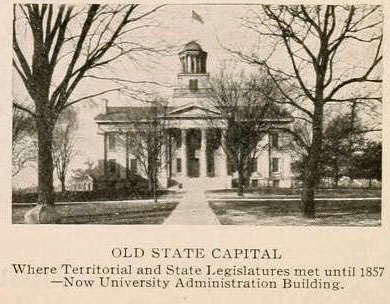 The
environments here are of the best. In this connection we take pride in
our Y.M.C.A. home, costing over $25,000, our public library, the finely
equipped university library and museum, our city parks, one of which
covers over eighty acres and is a garden spot supplied with attractions
for young people. The
environments here are of the best. In this connection we take pride in
our Y.M.C.A. home, costing over $25,000, our public library, the finely
equipped university library and museum, our city parks, one of which
covers over eighty acres and is a garden spot supplied with attractions
for young people.
A fine water system, recently equipped at a great
expense, with the most modern filters. The water is pumped not from the
Iowa river, but from an underground supply, assuring pure, wholesome,
water which is conducive to good health.+
A sewerage system, well installed, measures 25
miles in length, 25 miles of bitulithic paving adds to the appearance of
the city, also 40 miles of granatoid walks. Gas mains cover an area of
25 miles. For the care of the sick and unfortunate Iowa City has three
large, well equipped hospitals with 70 nurses and the best of medical
science in attendance. Three daily and one tri-weekly newspapers furnish
the news for Iowa City and vicinity.
A commercial club, located in quarters that would
be a cred- …
|
| 13 |
 |
|
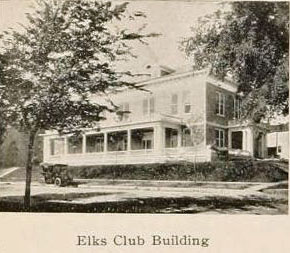 …
it to any city twice the size of Iowa City and with a membership of 250
is actively engaged in promoting the interests of the city and its
citizens. That Iowa City has a great future is evidenced by the
activities in interurbans at this time, now having a line to Cedar
Rapids on the north, two more interurbans are to be built. One to
Davenport on the east and one to Otumwa on the southwest. A street car
system will be built before snow flies in the autumn of 1910. …
it to any city twice the size of Iowa City and with a membership of 250
is actively engaged in promoting the interests of the city and its
citizens. That Iowa City has a great future is evidenced by the
activities in interurbans at this time, now having a line to Cedar
Rapids on the north, two more interurbans are to be built. One to
Davenport on the east and one to Otumwa on the southwest. A street car
system will be built before snow flies in the autumn of 1910.
Iowa City is to be the “Interurban Hub” of the
State of Iowa. The traveling salesman knows what this will mean to him
as an easy point of access. He is looking for a good city in which to
live to educate his family and give them the best of environment and at
the same time be able to get out over his territory on an hourly service
in most any direction and make connection with the steam railway trunk
lines in addition to the splendid service afforded north, east, south
and west over the Omaha main line of the Chicago, Rock Island and
Pacific Ry. Speaking of club advantages, this city
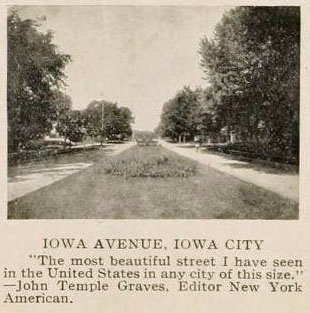 has
an Elks club building just recently completed costing over $35,000 and
is complete in every particular. The Country Club and golf links along
the beautiful Iowa river affords an excellent outing during the summer
months. has
an Elks club building just recently completed costing over $35,000 and
is complete in every particular. The Country Club and golf links along
the beautiful Iowa river affords an excellent outing during the summer
months.
Tourists and visitors are always welcome to all
Iowa City clubs and club buildings and a card addressed to the secretary
of the commercial club asking for information will bring to you more
details about Iowa City, the “City Beautiful,” and its citizens.
The Iowa City Automobile Club is a strong,
active organization and is doing excellent work in promoting the cause
for good, well drained highways.
In short, “Know Iowa City,” the educational
center of the middle west. The place for business, homes and education.
~ Robt. N. Carson.
|
| 14 |
 |
Tiffin
Tiffin is situated eight miles west of Iowa City
on the Rock Island railroad line and the Marengo road, the main highway
east and west through this section and part of the River to River Road
runs through the village, which has a population of 200. There is one
bank, a lumber yard, a coal yard, two large general stores, one meat
market, a blacksmith shop, an implement warehouse, two garages, a hotel,
four gasoline stations, and a tile factory employing twenty men. There
are two churches in the town. The Cartercar, the Overland and the
Oakland machines are handled by the local dealers. Thirty cars are owned
in the township. Tiffin is one of the greatest automobile centers in the
world for its size. Every other man thinks and talks car most of the
time. Tourists, as might be expected, are cordially welcomed and
information is given that is accurate.
Oxford An
incorporated town of about 1,000 inhabitants, located on the main line
of the C.R. I. & P.R.R., 252 miles west of Chicago. It has a large
number of stores of all kinds and is doing a prosperous business. The
township surrounding is rolling and best adapted to stock raising,
nearly all the productions of the township as well as adjoining ones,
are shipped from this point. During the past few years Oxford has gained
considerably in population, and will be no doubt continue to grow. The
town was laid out by C. S. Wilcox in 1869 or 1870, and since then
several additions have been added. |
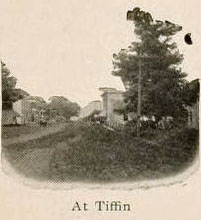 |
| 15 |
 |
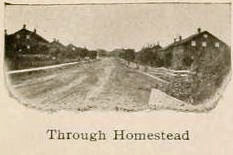 |
Amana Society
|
|
Homestead and South Amana are towns owned
by the Amana Society, which the tourist will find well worth careful
study. Strangers are kindly treated and assisted in every possible way
in these communities. The Amana Society is an organization of a
religious nature, but combines also methods and systems of living and
conducting business in a socialistic way that reflect great credit upon
the association. It is said that the society originated in Germany about
the year 1714 among those who desired a peaceful life, and with less
formality than was exercised by existing religious sects and
denominations. They were especially opposed to wars or any participation
therein, their position on this subject being summed up in the following
declarations:
First. The teachings of Christ forbid war.
Second. The precepts and practice of the apostles
agree with the teachings of Christ.
Third. The early Christians were firm in the
belief in the unjustness of war and many suffered death in affirmation
of this belief.
Fourth. War is not a necessary evil, for if the
people would not fight, ambitious rulers would either have to fight
themselves or dwell in peace and harmony.
Fifth. The general character of Christianity is
wholly inconsistent with war and its general duties are contrary to it.
Homestead and South Amana are towns owned by the
Amana Society, which the tourist will find well worth careful study.
Strangers are kindly treated and assisted in every possible way in these
communities. The Amana Society is an organization of a religious nature,
but combines also methods and systems of living and conducting business
in a socialistic way that reflect great credit upon the association. It
is said that the society originated in Germany about the year 1714 among
those who desired a peaceful life, and with less formality than was
exercised by existing religious sects and denominations. They were
especially opposed to wars or any participation therein, their position
on this subject being summed up in the following declarations:
First. The teachings of Christ forbid war.
Second. The precepts and practice of the apostles
agree with the teachings of Christ.
Third. The early Christians were firm in the
belief in the unjustness of war and many suffered death in affirmation
of this belief.
Fourth. War is not a necessary evil, for if the
people would not fight, ambitious rulers would either have to fight
themselves or dwell in peace and harmony.
Fifth. The general character of Christianity is
wholly inconsistent with war and its general duties are contrary to it.
|
Growth of the Society
|
|
The growth of the order by additions of
believers and a community of though led the society to lease land and
factories where they could bring their membership together, and little
by little they became socialistic and in time the idea of a community of
interest became a part of their faith and plan of life.
|
| 16 |
 |
|
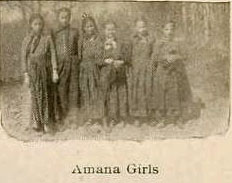 In
1842 Mons. Cabet’s book on communism, and imaginary utopian dream called
“The Voyage and Adventures of Lord Carisdal in Icaria,” seemed to
stimulate the society to a new movement in search of a new and broader
field and greater liberty of action, with less of the antagonism
experienced in the old country. So in 1842 four men were selected to
visit America and look up a new location. They reached this country
toward the last of October, 1842, and first examined lands near Lake
Chautauqua, in western New York, but were not suited. They then examined
lands near Buffalo, soon to be vacated by the Seneca Indians, and
finally purchased 5,000 acres at $10.50 an acre. Members of the society
to the number of fifty soon came over and in May, 1843, a village was
laid out and named Ebenezer. Later two other villages were platted and
called Upper and Lower Ebenezer, the first one being then called Middle
Ebenezer. A large meeting house was built, also school houses, as well
as dwellings and a saw mill. By the end of 1843 the community numbered
350 persons. Some trouble of an annoying nature was had with the
Indians, who were slow to vacate the lands, in time. In 1844 members had
come over from the old country until the membership reached 800. In
February, 1845, the society was incorporated; saw mills, grist mills and
woolen mills were built and additional land purchased until they were
owners of 8,000 acres. In
1842 Mons. Cabet’s book on communism, and imaginary utopian dream called
“The Voyage and Adventures of Lord Carisdal in Icaria,” seemed to
stimulate the society to a new movement in search of a new and broader
field and greater liberty of action, with less of the antagonism
experienced in the old country. So in 1842 four men were selected to
visit America and look up a new location. They reached this country
toward the last of October, 1842, and first examined lands near Lake
Chautauqua, in western New York, but were not suited. They then examined
lands near Buffalo, soon to be vacated by the Seneca Indians, and
finally purchased 5,000 acres at $10.50 an acre. Members of the society
to the number of fifty soon came over and in May, 1843, a village was
laid out and named Ebenezer. Later two other villages were platted and
called Upper and Lower Ebenezer, the first one being then called Middle
Ebenezer. A large meeting house was built, also school houses, as well
as dwellings and a saw mill. By the end of 1843 the community numbered
350 persons. Some trouble of an annoying nature was had with the
Indians, who were slow to vacate the lands, in time. In 1844 members had
come over from the old country until the membership reached 800. In
February, 1845, the society was incorporated; saw mills, grist mills and
woolen mills were built and additional land purchased until they were
owners of 8,000 acres.
|
Move to Iowa
|
|
After some years, for various reasons, the
elders of the community decided to look up a new location where a larger
area of cheaper land could be obtained, farther away from the unpleasant
influences of a rapidly growing city like Buffalo; so in 1855 the
society selected a committee to go west in search of a more satisfactory
locality. The committee finally reached Davenport, Iowa, then went to
Muscatine and from there up the Iowa river to Iowa City, where the state
capital had been located; from Iowa City they drove westward into Iowa
county, where settlement had just begun, where land was cheap, where the
soil was rich and where the broad rolling prairies and clear running
streams made a landscape most pleasing and attractive. Government land
could be bought at $1.25 an acre and settlers’ claims at $500 to $800 a
quarter section. The committee made its report and the society at once
bought 18,000 acres. Then began the removal of members from near Buffalo
to the new location in Iowa county, Iowa. Not all could some at once. It
took nearly ten years to accomplish the sale of the eastern property and
bring the last of the membership to Iowa. In the meantime, improvements
were made as rapidly as circumstances would permit. On acquiring
possession of the land they at once laid out a town about a mile north
of the Iowa river on a beautiful sloping prairie near a lake of about
200 acres and with a small stream running through the proposed village.
The name given it was Amana, found in the Songs of Solomon (Chap.
IV-18). The meaning of the word is “remain true.”
|
| 17 |
 |
|
Other villages were afterwards laid out, West
Amana, and South Amana in 1856, High Amana in 1857, East Amana in 1860,
Homestead in 1861, Middle Amana in 1862 and New South Amana in 1883.
When all had reached the new home from Buffalo the membership was 1,200.
The civil war caused them some embarrassment, but
they met conditions by furnishing money for the employment of an
equitable number of substitutes at $300 each.
|
Regularly Incorporated
|
|
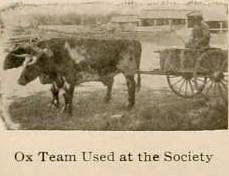 The
Amana Society is regularly incorporated under the laws of the state. Its
principal object is defined to be promotion of the temporal and
spiritual welfare and happiness of its members; and its principal
business to acquire real and personal property, to carry on agricultural
and mechanical pursuits, to build villages, churches, schools,
factories, etc. The legislative management of the society is in the
hands of thirteen trustees elected annually. The executive department
consists of one director, one vice-director and one secretary elected
annually by the trustees. The
Amana Society is regularly incorporated under the laws of the state. Its
principal object is defined to be promotion of the temporal and
spiritual welfare and happiness of its members; and its principal
business to acquire real and personal property, to carry on agricultural
and mechanical pursuits, to build villages, churches, schools,
factories, etc. The legislative management of the society is in the
hands of thirteen trustees elected annually. The executive department
consists of one director, one vice-director and one secretary elected
annually by the trustees.
The society makes steady improvement of its
property from year to year. More and more land was placed under
cultivation, a canal nine miles long was built to bring water from the
Iowa river and furnish power, taking three years to construct; an
artesian well was put down 1,600 feet, grist mills, saw mills, woolen
mills, cotton mills, hominy mills, a starch factory, soap factory, a
pepsin factory, stores, lumber and coal and cattle yards, school houses,
dwellings, meeting houses, barns and out-buildings constructed and all
else needed in the successful management of its affairs. The products of
its mills are “made upon honor,” the best of their kind, and find a
ready market. The Amana Society brand has won the implicit confidence of
the public.
The society has three physicians who look after
the sick or ailing.
|
| Eighty Elders |
|
Eighty elders look after spiritual matters,
conduct Sunday and Wednesday meetings and every evening prayer meetings.
They believe in the inspiration of the Bible and make it the cornerstone
of their faith. They endeavor to be guided in their lives by the
teachings of Christ and the Apostles.
|
| 18 |
 |
|
They believe in prayer, in the resurrection, and
in reward hereafter for the good and punishment for the wicked. They
indulge in singing, but not instrumental music.
All property is owned by the society. If a new
member comes in from outside he turns in his property and takes a
receipt for it. If afterwards he wishes to withdraw it is returned to
him without interest.
Each family has its own house and garden and
family ties are held sacred.
They believe in education and maintain good
schools.
They dress and live plainly, but their tables are
supplied with an abundance of the best of meats, vegetables, fruits,
etc.
The growth of the society is shown by the
statement that 800 came over from the old country and settled at
Buffalo; 1,200 came from Buffalo to Iowa and the membership in this year
of 1910 numbers about 1,800. The society now owns 25,000 acres of choice
land, thousands of head of cattle, sheep, hogs, horses and poultry, and
mills and factories that turn out many thousands of dollars worth of
products every year beyond the needs of the community.
The foregoing has been gleaned in part from an
interesting work by Wm. R. Perkins and B. L. Wick, entitled, “History of
the Amana Society or Community of True Inspiration,” published by the
University press at Iowa City.
|
|
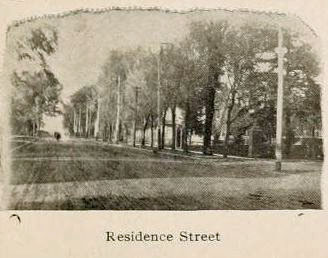 Marengo
This city is named after the plains of Marengo, where Bonaparte fought
his battle of “Marengo,” June 14, 1800. The original town of Marengo was
created by a commission to locate a seat of justice for Iowa county and
it is said that the commission which traveled in a platform buggy, and
after taking the necessary preventive against ague and other ailments,
decided that this valley where Marengo now stands is pretty enough for a
“Seat of Justice,” therefore Marengo has been the county seat of Iowa
county ever since by legislative act. Marengo
This city is named after the plains of Marengo, where Bonaparte fought
his battle of “Marengo,” June 14, 1800. The original town of Marengo was
created by a commission to locate a seat of justice for Iowa county and
it is said that the commission which traveled in a platform buggy, and
after taking the necessary preventive against ague and other ailments,
decided that this valley where Marengo now stands is pretty enough for a
“Seat of Justice,” therefore Marengo has been the county seat of Iowa
county ever since by legislative act.
Marengo is the center of one of the finest and
best agricultural districts in Iowa. Marengo is situated about midway
between Davenport and Des Moines and has in early days occupied that
distinction, as being the half way stop.
She now has a good substantial business, four
strong banks, twelve blocks of modern pavement, all the different
churches are represented, and up-to-date and enterprising business men.
Marengo has a population of 2,500 people. It has one of the best high
schools in the state of Iowa and has a big bunch of men that are
enthusiastic automobile men.
|
| 19 |
 |
 Ladora
The town of Ladora is in one of the best agricultural districts of the
state and about equal distance from Des Moines and Davenport on the main
line of the Rock Island. The place is a busy one, being an important
shipping point for grain and stock. Ladora
The town of Ladora is in one of the best agricultural districts of the
state and about equal distance from Des Moines and Davenport on the main
line of the Rock Island. The place is a busy one, being an important
shipping point for grain and stock.
Victor
Victor is one of the most enterprising centers of population
and business on the road. The census gives it in the neighborhood of
1,000 people. It owns its water works, is well lighted and has power
furnished by a dam in the creek. This dam operates the Victor Roller
Mills. Victor has fine schools. Of interest to tourists is the fact that
a good garage is here and that expert assistance is rendered and
supplies furnished as may be needed.
Brooklyn Brooklyn,
the lively town fifteen miles east of Grinnell, has a population of
about 1,500 and is an important railroad point, being a freight division
on the Rock Island railroad. Nearly all the flyers on the Rock Island
stop here going both ways, though many of them do not stop at the
station, but at the coaling chutes east of the station. It is
interesting to note that there is a first-class garage in Brooklyn, that
of B. W. Sloan, at which service and supplies can be obtained equal to
the best afforded in the larger cities. Brooklyn was considered as the
location of the state capital at the time it was moved from Iowa City to
Des Moines. |
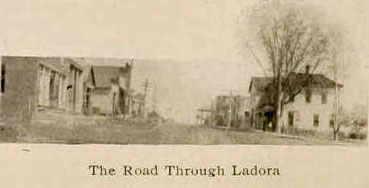 |
| 20 |
 |
Grinnell
|
|
 A
New England town in the heart of Iowa, the little city of Grinnell
stands unique among the communities of the state. Its streets, arched
over with trees, its well-kept green lawns, no less than the attitude of
its people toward moral and religious questions, help to convey the
impression of New England. A
New England town in the heart of Iowa, the little city of Grinnell
stands unique among the communities of the state. Its streets, arched
over with trees, its well-kept green lawns, no less than the attitude of
its people toward moral and religious questions, help to convey the
impression of New England.
Grinnell was founded by J. B. Grinnell, who came
to Iowa with the famous injection of Horace Greeley ringing in his ears:
“Go west young man, go west.” Mr. Grinnell came west and founded the
city which bears his name as a little Congregational settlement in the
heart of the bare Iowa prairie. From the first, Mr. Grinnell’s
personality made itself felt. During the troubled days before the Civil
War Grinnell was a hotbed of abolition feeling. It was one of the
stations on the famous “Underground Railroad,” which passed runaway
slaves onward in their search for freedom. John Brown, of Harper’s Ferry
fame, was a visitor at the Grinnell home, and many other famous men were
guests there. A great tree in the yard of the Grinnell homestead is
still known as the Beecher Elm.
Almost from the first Grinnell has been closely
identified with Grinnell College, formerly Iowa College. Town and
college have grown together.
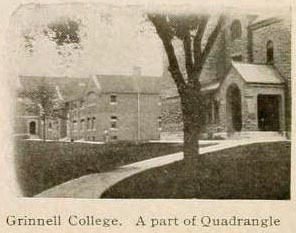 In
1882, the historic Grinnell cyclone swept them both, but both rose
stronger than ever before from their ruins. The cyclone was a blessing
in disguise for Grinnell as was the fire which destroyed the business
section a few years later, for as a result Grinnell has more modern
business blocks than are usually found in a town of this size. In
1882, the historic Grinnell cyclone swept them both, but both rose
stronger than ever before from their ruins. The cyclone was a blessing
in disguise for Grinnell as was the fire which destroyed the business
section a few years later, for as a result Grinnell has more modern
business blocks than are usually found in a town of this size.
Grinnell is healthfully located on one of the
highest points in Iowa. It has a population of about 5,500. It is
supplied with water from four artesian wells which give an abundant and
pure supply. The water works are municipally owned. The city is lighted
by electricity and gas, and is now being paved with bitulithic paving,
the contract for which is the largest single paving contract ever let in
the state of Iowa.
Grinnell is a hustling, progressive little city.
It has a live Commercial Club and an Automobile Club which does things.
It has a special in-…
|
| 21 |
 |
| … terest for automobilists from the fact that
automobiles are manufactured here. |
|
Grinnell is located on the main lines of the Rock
Island and Iowa Central railroads. It has beautiful homes, an excellent
school system, in addition to college (Carnegie) library, a fine city
library, and it is surrounded by the best farming country in Iowa.
It has two parks, one in the very heart of the
business section, one on the outskirts surrounding a beautiful
artificial body of water known as Arbor Lake.
From a physical, social, educational or religious
viewpoint Grinnell is preeminently fitted and is preeminently a home
city. Many move here to secure educational advantages for their children
and none are disappointed.
Grinnell courts investigation. It claims to be
the best city of its inches in Iowa.
|
|
Kellogg
Is in the eastern part of Jasper county. It was
laid out in 1865 before the railroad reached this point. It was the
terminus of the railroad for about a year and as a consequence received
considerable trade at that time, the road pushing through to Des Moines
1867. The town was incorporated in 1874 and a council organized the same
year.
Automobiles will find Craven’s Garage, which is
located here, one of the best equipped along the River to River road.
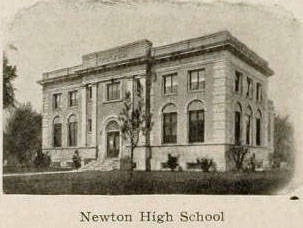 Newton
The county seat of Jasper county, is located on the C.,
R. I. & P., the Iowa Central and Ft. D., D. M. & S. railways, 35 miles
from Des Moines, 177 from Omaha, 140 from Davenport and 323 from
Chicago. Newton is rapidly growing in wealth and population; new
business enterprises are being established, new residences are being
built, new people are coming to locate here and grow up with the
increased business. Newton always extends the glad hand to anyone who
desires to locate within his borders and when the newcomer has resided
here long enough to turn around a few times and learn of the many
advantages of living in such a city he never wants to leave. Newton
feels justly proud of her schools, her churches, her own electric light
plant, her own water works system, and above all Newton is proud of her
people. Newton has twenty-two factories, which employ about 600 people
with a monthly pay roll at about $6,000.00. There are several excellent
garages here and the town is a good one to make a night stop. Newton
The county seat of Jasper county, is located on the C.,
R. I. & P., the Iowa Central and Ft. D., D. M. & S. railways, 35 miles
from Des Moines, 177 from Omaha, 140 from Davenport and 323 from
Chicago. Newton is rapidly growing in wealth and population; new
business enterprises are being established, new residences are being
built, new people are coming to locate here and grow up with the
increased business. Newton always extends the glad hand to anyone who
desires to locate within his borders and when the newcomer has resided
here long enough to turn around a few times and learn of the many
advantages of living in such a city he never wants to leave. Newton
feels justly proud of her schools, her churches, her own electric light
plant, her own water works system, and above all Newton is proud of her
people. Newton has twenty-two factories, which employ about 600 people
with a monthly pay roll at about $6,000.00. There are several excellent
garages here and the town is a good one to make a night stop.
|
| 22 |
 |
Colfax
The Carlsbad of America
|
|
Like ancient Rome is Colfax - built upon
its seven hills. But unlike Rome, no Nero ever will fiddle as Colfax
burns, for Colfax owns its own water works and it is one of the most
up-to-date systems in the world, furnishing ample protection against
disaster by fire.
Another appellation European has this noted Iowa
resort gained - it is called the Carlsbad of America. Throughout the
country has its mineral water brought it fame. While in a sense Colfax
owes it popularity to the curative properties of its water, as a place
for passing one’s vacation it has few equals, if a sojourn next to
nature is desire of the visitor.
Nominally the town has 4,000 inhabitants. This
must not be reckoned its actual size, for thousands upon thousands of
outsiders multiply this population yearly, many times. Last year the
resort entertained 25,000 guests and never was there a time when its
resources were inadequate for taking care of the transients.
The city is built around a natural amphitheater.
Its arrangement of streets is picturesque. Outdoor beauties, natural and
built by man, combine to make the community a heaven of rest and quiet.
With the abundance of water on every hand it follows that foliage and
bloom are everywhere to be found.
Trees so abundant as to almost amount for forests
cover the hills to the east and south. North of town runs a placid
stream, which lends an added charm to the landscape. A soft south breeze
prevails. The elevation is acceptable - 800 feet. The air is clear and
bracing. There Is plenty of opportunity for fishing and boating, as in
the case in regard to the various forms of indoor and outdoor
recreation.
Colfax is twenty-three miles east of Des Moines
on the Chicago-Colorado main line of the Rock Island Lines. It is on the
Colfax Northern,
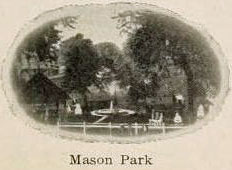 which
connects with the Great Western, and is on the Fort Dodge, Des Moines
and Southern Railway. which
connects with the Great Western, and is on the Fort Dodge, Des Moines
and Southern Railway.
The city has enough large and well equipped
hotels and sanitariums. In keeping with the grandeur of the hills upon
which it is situated are its beautiful drives and walks. It has the
Chautauqua grounds of the Iowa State Epworth League Assembly, conceded
to be the finest part of its kind in that section of the west.
It well may boast of its fine churches. Its
schools are of the best. It is lighted by modern electric system and has
excellent sewerage. There are located in the city, banks, mercantile
houses, a telephone system, three express lines, electric street …
|
| 23 |
 |
 …
car line, and three plants which bottle its famous water, more than 400
carloads are sent to all parts of the United States annually. …
car line, and three plants which bottle its famous water, more than 400
carloads are sent to all parts of the United States annually. Colfax
has a public library the like of which cities several times its size
would be proud to own. The city is the permanent seat of the Iowa State
Epworth League Assembly. This institution in addition to its beautiful
grounds, has an auditorium the second largest in the state. An electric
line connects the grounds and the city.
The Chautauqua Assembly at Colfax is now in its
fifteenth year. This is a considerable longer period than is usual with
most of the institutions of that character. The reason for its longevity
is the gradual building up plan which has been the order since the
Assembly started. The management has never gone on the plan of
“cheapness.” None but the best of attractions ever have been billed
there. This accounts for the Assembly’s successful past and its rosy
future.
But notwithstanding these advantages it
undoubtedly is a fact that Colfax as a remedial center is Colfax at its
best. For the value of Colfax waters is undisputed and indisputable.
There is an old expression “unstable as water,”
in which some people place faith, but while, as can be seen, the fame of
Colfax is founded upon water, just as easily it can be seen that the
fame of Colfax is by no means unstable.
Mineral water first was discovered in Colfax in
1875 by persons prospecting for coal, which since has been found in
abundance in the hills
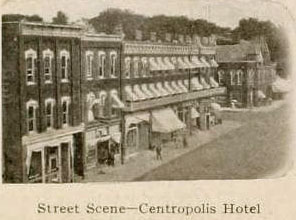 skirting
the Chasaqua River. skirting
the Chasaqua River.
The prospector’s drill penetrated through
successive strata of late until at a depth of 315 feet, when the drill
was still apparently piercing solid rock, a great gush of water came,
which stopped explorations for coal in that particular spot.
Naturally there was disappointment felt at this
sudden halting of the plans to get rich. One of the prospectors jokingly
accepted the situation with this philosophy: “Well let’s sample what we
got, anyhow.” With that he tasted the water.
Being somewhat of a chemist, at the first swallow
he perceived that the fluid was not ordinary aqua pura. He and his
companions continued to drink of it while they were moving their
machinery and were agree- …
|
| 24 |
 |
| … ably surprised at its bracing effect as a tonic.
So convinced was the leader that he had made a “find,” that he made
further investigation. He took a sample to
the chemical laboratory and had a thorough analysis made of it. The test
more than bore out his sanguine expectations.
The examination of the mineral waters proved that
the search for coal though unsuccessful, had resulted in finding, not of
Ponce de Leon’s Fountain of Youth, but as close a substitute as obtains
outside the realm of fiction. The report of the chemists on the fluid
was proof that it was of much more value than the fuel that had been
sought.
There was a boom after that in the hunt for
water. The work of piercing the earth was continued. At the present time
there are nineteen artesian wells giving forth their great remedial
product and the city has built up year by year, its reputation as a
health restoring center.
 Mitchellville
Is a thriving town of 700 inhabitants, situated
eighteen miles east of Des Moines on the Rock Island and Interurban
railways. It is a typical prosperous village, with well-kept streets and
sidewalks. Its many pleasant homes, surrounded by neat lawns amid shade
trees of maple, elm and box elder, present a pleasing picture to the
passer-by. Four churches and an excellent public school bear witness to
the moral and intellectual ideals of the people. The streets are lighted
with kerosene gas. South of the town is the State Industrial School for
Girls, with ample buildings and a pleasant campus. The business men of
the town are expecting the establishment of a garage. Mitchellville
Is a thriving town of 700 inhabitants, situated
eighteen miles east of Des Moines on the Rock Island and Interurban
railways. It is a typical prosperous village, with well-kept streets and
sidewalks. Its many pleasant homes, surrounded by neat lawns amid shade
trees of maple, elm and box elder, present a pleasing picture to the
passer-by. Four churches and an excellent public school bear witness to
the moral and intellectual ideals of the people. The streets are lighted
with kerosene gas. South of the town is the State Industrial School for
Girls, with ample buildings and a pleasant campus. The business men of
the town are expecting the establishment of a garage.
Altoona Is
a village on the Rock Island main line, ten miles east of Des Moines,
and is where the tracks of the main line and the Des Moines Valley
division diverge. The Des Moines Valley division goes to Keokuk, by way
of Oskaloosa, Ottumwa and Eldon. |
| 25 |
 |
Des Moines
|
|
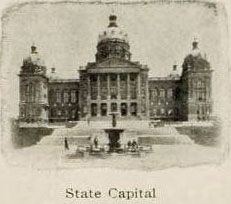 Des
Moines, the capital of the state and the chief commercial city of
central Iowa, is situated at the junction of the Des Moines and Raccoon
rivers and is on the Chicago-Omaha line of the Rock Island railway, and
the Chicago-Kansas City line of the Chicago Great Western railroad.
Besides these two main lines of road it is the terminus of important
branches of the Milwaukee, Wabash, Burlington, Northwestern and other
systems. It is also the center of the only extensive system of
interurban railways between the Mississippi river and the Rockies. In
the last five years the city, now with a population of about 100,000,
has been marvelously improved and beautified until Des
Moines, the capital of the state and the chief commercial city of
central Iowa, is situated at the junction of the Des Moines and Raccoon
rivers and is on the Chicago-Omaha line of the Rock Island railway, and
the Chicago-Kansas City line of the Chicago Great Western railroad.
Besides these two main lines of road it is the terminus of important
branches of the Milwaukee, Wabash, Burlington, Northwestern and other
systems. It is also the center of the only extensive system of
interurban railways between the Mississippi river and the Rockies. In
the last five years the city, now with a population of about 100,000,
has been marvelously improved and beautified until
 it
is now recognized as being one of the most attractive and modern of all
the cities in the United States. Many large buildings of artistic design
have been erected and this, with a general remodeling of interiors and
exteriors in the downtown district, together with a most comprehensive
scheme of lighting the streets by means of the artistic electroliers,
gives the town a metropolitan aspect. The hotel accommodations are ample
and good restaurants are many. it
is now recognized as being one of the most attractive and modern of all
the cities in the United States. Many large buildings of artistic design
have been erected and this, with a general remodeling of interiors and
exteriors in the downtown district, together with a most comprehensive
scheme of lighting the streets by means of the artistic electroliers,
gives the town a metropolitan aspect. The hotel accommodations are ample
and good restaurants are many.
This city is especially stronger as a retail
center and as the center of large publishing and insurance business. It
is getting strong yearly in the field of general manufacturing and
jobbing.
Governmentally, Des Moines is under what has come
to be known everywhere as the Des Moines Plan. This plan is government
by a commission of five members, chosen at a non-partisan election and
at large, instead of from wards. The plan appears to have worked well,
and the city believes itself to be getting dollar for dollar in the
matter of expenditures and results.
|
| 26 |
 |
|
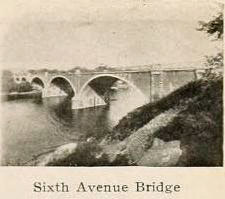 Garages
are legion and the fact that all seem to be doing a lively business
indicates that this is the automobile center of the middle part of the
state. There are a number of fine drives through the city, which covers
over fifty square miles of area. The park system is on a magnificent
scale in preparation for the needs of a city of half a million people. Garages
are legion and the fact that all seem to be doing a lively business
indicates that this is the automobile center of the middle part of the
state. There are a number of fine drives through the city, which covers
over fifty square miles of area. The park system is on a magnificent
scale in preparation for the needs of a city of half a million people.
In addition to the trade and farm papers that are
published in Des Moines, the city has four dailies that compare
favorably with publications of like nature in cities of twice the size.
The Register and Leader is a morning paper with a state-wide circulation
and has an evening issue called the Tribune. In the evening field,
strictly, are the Capital, published by Lafayette Young, the famous
orator and publicist, and the News, of the Scripps-McRae syndicate. The
Capital is a political power with the conservative or standpat wing of
the Republican party and is widely read by people of all shades of
political opinion on account of its high quality as a newspaper and the
entertaining nature of its editorial page. The News is more or less
gently sensational and has screaming headlines three or four times a
day. On account of the large street sales of all these papers, Des
Moines is the paradise for newsboys, several of whom have amassed
fortunes in their lines of business.
Organized boosting has made Des Moines what it is
and the harmony existing in the general effort to promote the growth and
development of
 the
town is often the cause of remark by strangers. Many thousands of
dollars are spent annually in advertising Des Moines as the “city of
certainties” and such mediums as the Saturday Evening Post are freely
used for full-page displays. The Greater Des Moines Committee is the
organization that has this remarkable publicity campaign in charge and
it is said that results of a substantial nature are already in sight. the
town is often the cause of remark by strangers. Many thousands of
dollars are spent annually in advertising Des Moines as the “city of
certainties” and such mediums as the Saturday Evening Post are freely
used for full-page displays. The Greater Des Moines Committee is the
organization that has this remarkable publicity campaign in charge and
it is said that results of a substantial nature are already in sight.
The capitol building on the east side of the Des
Moines river is well worth a visit from the tourist, as is also the
state library and historical building nearby. The Melan arch bridge of
concrete at the Locust street crossing of the Des Moines river is also
noteworthy, as is also the new half-million dollar postoffice building,
an admirable example of Uncle Sam’s new ideas of what government
buildings of this sort ought to be. The Polk County court house is a
magnificent pile and the more recently constructed sky-scraping office
buildings are equal …
|
| 27 |
 |
| … to their kind in the largest cities so far as
construction and equipment are concerned. Out
Grand avenue, going west from the business district by the way, one gets
a good impression of one of the most beautiful residential streets in
the entire United States. Around Des Moines, indeed, is one of the most
picturesque countries in Iowa. The native woods of this section help
greatly to give this effect.
|
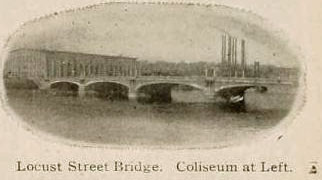 |
| 28 |
 |
| |
|
Waukee
a town of 400 inhabitants, is situated at the junction of the C. M. St.
P., C., R. I. & P. and the M. & St. L. railroads, about fifteen miles
west of the city of Des Moines on the River to River Road, and is
located in one of the richest farming communities in the state of Iowa,
which was formerly quite low and wet, but has recently been thoroughly
tiled and is now one of the best agricultural communities of which we
know.
|
|
Land values range from $125 to $200 per
acre, according to location and improvements. It is a great grain and
stock center; about 300,000 bushels of grain and 150 cars of stock are
shipped from here annually.
There are a first-class lumber yard, four general
stores, an up-to-date restaurant, a three-story brick hotel, two banks,
a blacksmith shop, a furniture store, two grain elevators, an implement
store, a livery barn, a drug store, a wall paper store, a harness shop,
a barber shop, a butcher shop, a feed mill, a nursery, a gasoline supply
station, four churches, three lodges, a ladies’ club, an physician, a
good school of twelve grades, a good ball ground and park with plenty of
shade, an excellent spot for picnics. Here, also, are the offices and
headquarters of the Ne Plus Ultra Generator Company, who handle the best
automobile acetylene gas light on the market.
The main streets are all heavily cindered and a
number of improvements are being made this year.
The Automobile Club, together with the township
officers, have made arrangements, and are keeping both the Lake Road and
the River to River Road to and from Waukee, dragged at all times when
needed, and in the best of condition.
|
| Adel
is on the C., M. & St. P. R’y, twenty-two miles west of Des Moines, and
has a population of 1,500. It has the reputation of being the prettiest
town in the state, a name gained from its natural advantages and its
modern improvements. Among the latter are electric lights, water works,
sewer system, public park, paved business streets, thirty miles of
cement walks, beautiful residences, thousands of fine shade trees, etc.
These, together with the magnificent new court house and the modern
depot built by the Milwaukee, give a metropolitan and stylish appearance
and the conveniences of the city, while combining the advantage of
suburban life. These conditions have not been brought to exist in a day,
nor a year or a dozen years. |
| 29 |
 |
|
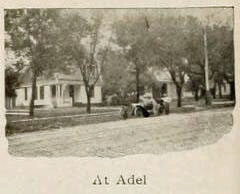 Among
the institutions that go to make Adel up-to-date, of a more or less
public nature, are the following: Unsurpassed public schools, with
eleven teachers; four churches, the Methodist, Presbyterian, Christian
and Adventist; two immense brick and tile factories, large flouring
mill, bonnet and glove factory, Dr. Scott’s Sanitarium, printing press
factory, cigar factory, elegant modern opera house. Besides the above,
there is the full complement of professional and mercantile
institutions, shops, etc., operated by wide-awake business men and
women. The fraternal and social side is well represented by lodges of
the Masons, Odd Fellows, Knights of Pythias, A.O.U.W. and the Daughters
of Rebekah orders, the G.A.R., the W. R.C., several social and literary
clubs, etc. Adel numbers among its citizens many first-class musicians,
a band is maintained and gives street concerts during the summer, and in
vocal music the town is in the front rank. Athletics are given proper
attention, lawn tennis, baseball, football, rowing, etc., receiving a
place in the program of amusements that entertain the resident and the
visitor in a manner each enjoys. Among
the institutions that go to make Adel up-to-date, of a more or less
public nature, are the following: Unsurpassed public schools, with
eleven teachers; four churches, the Methodist, Presbyterian, Christian
and Adventist; two immense brick and tile factories, large flouring
mill, bonnet and glove factory, Dr. Scott’s Sanitarium, printing press
factory, cigar factory, elegant modern opera house. Besides the above,
there is the full complement of professional and mercantile
institutions, shops, etc., operated by wide-awake business men and
women. The fraternal and social side is well represented by lodges of
the Masons, Odd Fellows, Knights of Pythias, A.O.U.W. and the Daughters
of Rebekah orders, the G.A.R., the W. R.C., several social and literary
clubs, etc. Adel numbers among its citizens many first-class musicians,
a band is maintained and gives street concerts during the summer, and in
vocal music the town is in the front rank. Athletics are given proper
attention, lawn tennis, baseball, football, rowing, etc., receiving a
place in the program of amusements that entertain the resident and the
visitor in a manner each enjoys.
The North Coon river, upon which Adel is located,
is a beautiful stream which affords facilities for boating, bathing and
fishing that are among the best in the state. Several nice boats and
launches are on the water and more will follow, as Riverside Park is
improved. This park, the property of the town, is an ideal place for
recreation.
Redfield
dates its settlement from about 1853 and is, therefore, one of the
oldest towns in the county. It was named after Col. James Redfield. With
this town are associated the names of many of the oldest settlers of the
county, and here the Dallas-Guthrie Old Settlers’ Association holds its
annual picnics. The town is built at the junction of the South and
Middle Raccoon rivers. It is nine miles west of Adel on the C. M. & St.
P. railroad. The town site is one of more than ordinary beauty. For
several years past it has probably done more in substantial improvement,
in proportion to its size, than any other town in the county.
Dale City
is a beautiful town eight and nine-tenths miles west of
Redfield.
Montieth
is six and half miles west of Dale City and is the market place for a
most prosperous and progressive community.
|
| 30 |
 |
Guthrie Center
|
|
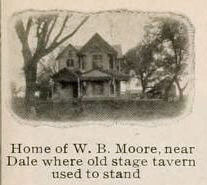 The
pioneers of Iowa parted company with the railroad at Chicago, and
plodded their way in prairie schooners across trackless prairies,
following the line of least resistance, making first settlements by the
wayside, and it is interesting to note that the tide of emigration, the
great western trail of civilization, closely followed the present River
to River Road across Guthrie county and through Guthrie Center. The site
of the very first cabin built in Guthrie county is to be seen on the
River to River Road, and is marked by an appropriate signboard. The
overland stage route from Des Moines to Council Bluffs likewise followed
Nature’s highway for many miles through Guthrie county, closely
coinciding with the present-day River to River Road, and one of the old
stage barns, with its dim and battered signboard, still adorns the
wayside, a grim reminder of by-gone days. It has been said that the
finger of Divine Love traced this natural highway through our rolling
prairies and gently sloping valleys, and today a thorough organization
of wide-awake farmers in Guthrie county is taking advantage of what
Nature has done for them, and aspire to make this section of the River
to River Road the best and most attractive piece of dirt highway in the
entire state. The
pioneers of Iowa parted company with the railroad at Chicago, and
plodded their way in prairie schooners across trackless prairies,
following the line of least resistance, making first settlements by the
wayside, and it is interesting to note that the tide of emigration, the
great western trail of civilization, closely followed the present River
to River Road across Guthrie county and through Guthrie Center. The site
of the very first cabin built in Guthrie county is to be seen on the
River to River Road, and is marked by an appropriate signboard. The
overland stage route from Des Moines to Council Bluffs likewise followed
Nature’s highway for many miles through Guthrie county, closely
coinciding with the present-day River to River Road, and one of the old
stage barns, with its dim and battered signboard, still adorns the
wayside, a grim reminder of by-gone days. It has been said that the
finger of Divine Love traced this natural highway through our rolling
prairies and gently sloping valleys, and today a thorough organization
of wide-awake farmers in Guthrie county is taking advantage of what
Nature has done for them, and aspire to make this section of the River
to River Road the best and most attractive piece of dirt highway in the
entire state.
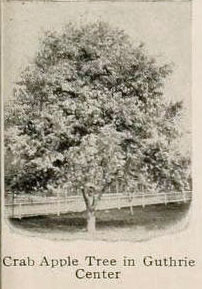 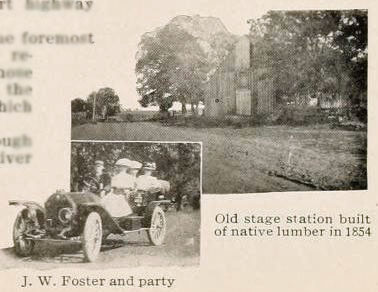 The
county of Guthrie stands among the foremost in general agriculture and
stock raising resources, fully meeting all expectations in those lines;
but, what is more important to the casual traveler, is the scenic beauty
which meets the eye at every turn of the road. The
county of Guthrie stands among the foremost in general agriculture and
stock raising resources, fully meeting all expectations in those lines;
but, what is more important to the casual traveler, is the scenic beauty
which meets the eye at every turn of the road.
A literary man who recently passed through
Guthrie Center, traversing the River to River Road, paid tribute as
follows: “The road follows naturally along easy grades, and in point of
upkeep rivals a race track, and it leads through a country of surpassing
interest. Nowhere within the limits of the great state of Iowa is the
county of Guthrie …
|
| 31 |
 |
| … surpassed for its beautiful scenery, its hills
and dales, its rolling prairies and emerald seas beneath the summer
skies, interspersed by hills, and natural groves, and meandering
streams, like bright ribbons of silver, rolling their pellucid waters in
banks of richest hues.” 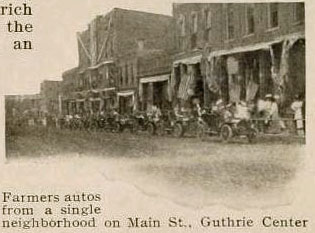 Amid
these beautiful scenes, in the South ‘Coon Valley, is Guthrie Center,
county seat and county metropolis of Guthrie county, drawing trade from
a rich and vast farming territory. Its business men are alive to the
demands of the times, carrying splendid stocks of goods in all lines. It
has water works, an electric light plant, two splendid parks, good
hotels, creamery, flouring mills, fore company, a military band of more
than statewide reputation, and no end of churches and civic societies.
It is adorned with Amid
these beautiful scenes, in the South ‘Coon Valley, is Guthrie Center,
county seat and county metropolis of Guthrie county, drawing trade from
a rich and vast farming territory. Its business men are alive to the
demands of the times, carrying splendid stocks of goods in all lines. It
has water works, an electric light plant, two splendid parks, good
hotels, creamery, flouring mills, fore company, a military band of more
than statewide reputation, and no end of churches and civic societies.
It is adorned with
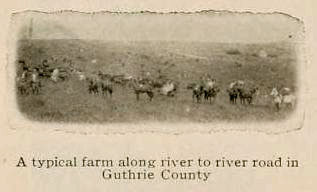 beautiful
tree-embowered homes, and is graced by buildings that would do credit to
a much larger place. It has a live Commercial Club and an Automobile
Association affiliated with the state and national associations, which
in membership is out-ranked by only two other automobile associations in
Iowa. There are three garages, one of them just completed, being fire
proof with machine in connection, adjoining electric light plant. beautiful
tree-embowered homes, and is graced by buildings that would do credit to
a much larger place. It has a live Commercial Club and an Automobile
Association affiliated with the state and national associations, which
in membership is out-ranked by only two other automobile associations in
Iowa. There are three garages, one of them just completed, being fire
proof with machine in connection, adjoining electric light plant.
|
| 32 |
 |
|
North Branch
is a town eleven and four-tenths miles east of
Exira and is interesting to the tourist on account of the pastoral
beauty of the scene.
Exira is
a city of 1,000 inhabitants and lies on the east bank of the Nishnabotna
river in the southern part of Audubon county. It is surrounded by farms
in a high state of cultivation. Its people and business men mostly got
their start on the farm. Within a radius of ten miles are five of the
most prosperous creameries in Iowa. Exira is situated in a natural
forest and the shady streets and pleasant park are known to all that
part of the state. The town has supported a fine concert band for
thirty-five years, and it gives Saturday evening outdoor concerts during
the summer months. Also its baseball nine is a famous one and the town
has not missed having a Fourth of July celebration for the last
forty-three years. The practice of the merchants and buyers to pay the
highest price for produce and live stock has educated the farmers of the
vicinity to make Exira their market town.
Oakfield is
the first town west of Exira and is a thriving burg and, and like nearly
all the towns of this part of the state, remarkable for its beauty and
prosperous air.
Lorah
is east of Atlantic and is well worth a visit by the tourist,
on account of the affability of the people of the town, which is a
market place of importance.
Atlantic
Is the county seat of Cass county, a beautiful city of 6,000 people in
the heart of the best farming section in the country. It is situated on
the main line of the Rock Island, eighty-two miles west of Des Moines
and sixty miles east of Council Bluffs, and is the junction point for
two branches of the Rock Island, one north to Audubon and the other
south to Griswold. The other railroad connections are afforded in the
Atlantic Northern and Southern, which runs to Kimballton and Elkhorn, a
railroad built by popular subscription.
Atlantic has more automobiles in the town
and county than any other of its size in the country. Three garages
operate here and do a thriving business. The people are happy,
prosperous and contented. The town is an ideal place in which to live
and one of the most delightful points on the River to River Road.
Marne
is on the C., R. I. & P. R’y., seven miles west of Atlantic. It
has a population of about 500. |
| 33 |
 |
|
Avoca
Pottawattamie county is a long one, east and west, and for that reason
it is convenient for the people to have two county seats. One of these
is Avoca. This town of 2,000 people is situated thirty-eight miles east
of Council Bluffs on the main line of the Rock Island railroad. It has a
fine garage, 48x99 in dimensions, and a first-class hotel. There are
three strong banks. Under the direction of the city council and the
township trustee, the public highways leading to and from Avoca are kept
in the best of condition for automobiles. Courtesy and good cheer are
elements in the
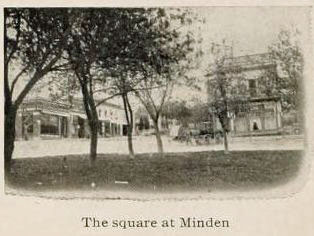 welcome
the tourist receives at Avoca. A public band concert is held every
Wednesday evening and the traveler is indeed fortunate if one is in
Avoca on those occasions. welcome
the tourist receives at Avoca. A public band concert is held every
Wednesday evening and the traveler is indeed fortunate if one is in
Avoca on those occasions.
Minden
Twenty-five miles northeast from Council Bluffs, on the main line of the
Rock Island and Great Western railroads, in the town of Minden, 500
population, staunch business point, in a township settled largely by
Germans and displaying effect of the energy, thrift and intelligence of
the farmers of that nation. There is abundant shade in the town,
concrete walks, a fine park with a band stand from which, now and then,
the Minden Cornet Band entertains the public. The Glidden tourists
remember Minden with pleasure.
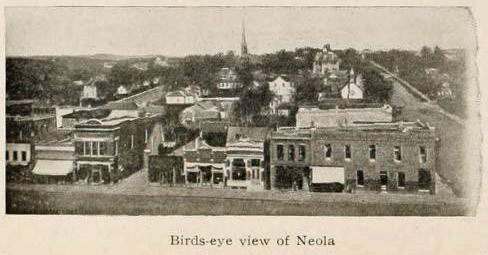 Neola
Is on the main lines of the Rock Island and Milwaukee railroads, about
twenty miles east of Council Bluffs. It has a population of 1,100 souls.
The town is lighted with electricity and has its own water works. Neola
is noted for its volunteer fire department, which holds the world’s
record for fast work. The school buildings are ample and modern and have
an attendance of about 400. Two cement factories are among the local
industries and there are a number of buildings of cement construction,
and sidewalks of cement in all part of the town. There is a good garage
that does all sorts of repairing and rents machines. Thirteen autos are
owned and used in the town. Neola
Is on the main lines of the Rock Island and Milwaukee railroads, about
twenty miles east of Council Bluffs. It has a population of 1,100 souls.
The town is lighted with electricity and has its own water works. Neola
is noted for its volunteer fire department, which holds the world’s
record for fast work. The school buildings are ample and modern and have
an attendance of about 400. Two cement factories are among the local
industries and there are a number of buildings of cement construction,
and sidewalks of cement in all part of the town. There is a good garage
that does all sorts of repairing and rents machines. Thirteen autos are
owned and used in the town.
|
| 34 |
 |
|
Underwood
is a small town between Council Bluffs and Neola and, like all the
villages of this part of the state, is clean and progressive.
Weston is
practically a suburb of Council Bluffs, which lies to the west of the
village.
Council Bluffs
is an old city and was at one time the transfer point for
all travel to and from the West. It has enormous railroad yards in its
limits. These yards lie chiefly between the city proper and Omaha,
across the river. Council Bluffs is beautiful in its residence part, up
among the hills. A magnificent view of all the surrounding country in
the two states may be obtained from the heights in Fairmount park. The
population of Council Bluffs is about 30,000. This city is the western
terminus of the River to River Road. Here the great Missouri river
separates Iowa from Nebraska.
This beautiful city, nestled in the hills
that overlook the broad bottom of the Missouri river, has long been one
of the principal trading points in the West and shows no decline in its
strength in this respect. In fact, it is a distributing center of first
rank in many lines of trade, made so by its unparalleled shipping and
trackage facilities, since all of the railroad systems of the East and
West meet here, and transfer is easy and speedy. Council Bluffs holds
the Iowa trade as against Omaha, its Nebraska neighbor across the river.
Perhaps as many autos are to be seen in Council Bluffs as in any city of
its size in the country. There are many machines owned locally and there
is a constant stream of tourists starting over the River to River Road
or arriving after having traversed that marvelously excellent highway.
Mr. H. A. Searie, of Counci8l Bluffs, is one of
the leading movers for good roads in the state and his influence and
energy, have been potent for the making of the River to River Road.
|
| 35 |
 |
Davenport, Muscatine, West Liberty
|
|
Blue Grass is pleasantly located on the Muscatine
branch of the River to River Road in the south part of the township of
the same name. It is surrounded by a fine farming country and is but a
short distance from a number of coal mines.
|
Muscatine
|
|
Muscatine, with a population of about
20,000, is one of the leading cities of Iowa. It is situated
twenty-eight miles southwest of Davenport on the Chicago-Kansas City
lines of the Rock Island and Chicago, Milwaukee & St. Paul railroads.
The town is one of the principal manufacturing points in the West and
the chief seat of the button making industry. On account of the fact
that the process of making buttons from clam shells, from the cutting of
the shells to the sewing of the finished project on cards, requires the
use of many hands, employment is furnished to all who apply, and
 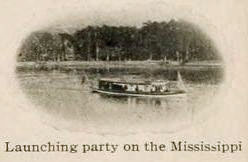 prosperity
is, therefore, very generally diffused. The booster spirit is strong and
there is no question that the city’s future is to be very bright. It is
said that Muscatine has more telephones for its population than any
other city in the world. The tourist will find everything he can desire
in the way of garage accommodations and supplies in this city, and in
its surroundings will discover one of the most picturesque scenes of
river and wooded hills anywhere in the West. Near Muscatine are the
principal gardens of the Heinz company, the makers of so many varieties
of pickles and preserves. The soil hereabouts is peculiarly adapted to
the successful culture of vegetables and small fruits and the region is
famous all over the country for its melons. While it is off the River to
River Road, a branch runs from West Liberty to Muscatine and from
Muscatine to Davenport. prosperity
is, therefore, very generally diffused. The booster spirit is strong and
there is no question that the city’s future is to be very bright. It is
said that Muscatine has more telephones for its population than any
other city in the world. The tourist will find everything he can desire
in the way of garage accommodations and supplies in this city, and in
its surroundings will discover one of the most picturesque scenes of
river and wooded hills anywhere in the West. Near Muscatine are the
principal gardens of the Heinz company, the makers of so many varieties
of pickles and preserves. The soil hereabouts is peculiarly adapted to
the successful culture of vegetables and small fruits and the region is
famous all over the country for its melons. While it is off the River to
River Road, a branch runs from West Liberty to Muscatine and from
Muscatine to Davenport.
The credit for the making of a branch of the
River to River Road to Muscatine, by means of a detour leaving the
direct route at Davenport and West Liberty, is very largely due to two
Muscatine gentlemen who are leading advocates of good roads and auto
enthusiasts: Mr. J. L. Geisler and Dr. F. H. Little.
|
| 36 |
 |



 Iowa’s
River to River Road, extending from Davenport to Council Bluffs across
what the whole world grants is one of the garden places of earth, is one
of those instances of highway making which have come about through the
co-operative effort of the people of many cities and towns and their
adjacent country sides, acting in accordance with plans prepared by
automobile owners and makers. These thoroughfares are extending to all
parts of the United States and it is already certain that they are to
form the basis of that comprehensive development of good roads which has
been long desired for comfort and long demanded by economic
requirements, but which, until the great automobile endurance tours
came, did not seem possible of speedy attainment. The farmer had felt
keenly for years his need of good highways; but, except in a very
partial way, he did not realize much of his hopes in that direction
until the auto enthusiast joined with him in efforts to reach a common
end. In the case of Iowa’s River to River Road, the famous Glidden tour,
scheduled to pass along its length if it could be made available, was
the immediate occasion for the improvement of the highway. Committees of
business and professional men and farmers in each county gladly and
energetically assumed the responsibility and expense of preparation of a
part of this road. The King drag was brought into action, fills were
made where necessary, and, in so short a time that the achievement
seemed little less than miraculous, an excellent highway in all weathers
was prepared the width of the Hawkeye state, a highway doubtless
destined to such further improvement in the near future that it will
become part of a great national pike on the way between Chicago and
Denver.
Iowa’s
River to River Road, extending from Davenport to Council Bluffs across
what the whole world grants is one of the garden places of earth, is one
of those instances of highway making which have come about through the
co-operative effort of the people of many cities and towns and their
adjacent country sides, acting in accordance with plans prepared by
automobile owners and makers. These thoroughfares are extending to all
parts of the United States and it is already certain that they are to
form the basis of that comprehensive development of good roads which has
been long desired for comfort and long demanded by economic
requirements, but which, until the great automobile endurance tours
came, did not seem possible of speedy attainment. The farmer had felt
keenly for years his need of good highways; but, except in a very
partial way, he did not realize much of his hopes in that direction
until the auto enthusiast joined with him in efforts to reach a common
end. In the case of Iowa’s River to River Road, the famous Glidden tour,
scheduled to pass along its length if it could be made available, was
the immediate occasion for the improvement of the highway. Committees of
business and professional men and farmers in each county gladly and
energetically assumed the responsibility and expense of preparation of a
part of this road. The King drag was brought into action, fills were
made where necessary, and, in so short a time that the achievement
seemed little less than miraculous, an excellent highway in all weathers
was prepared the width of the Hawkeye state, a highway doubtless
destined to such further improvement in the near future that it will
become part of a great national pike on the way between Chicago and
Denver. ...such
a public man have of his career of effort in the general interest?
Through the columns of his paper Mr. Young gave freely and without limit
the needed initial publicity for the organization of the project, and
the bright young men of the Capital were always and everywhere on the
ground, recording the progress of the work as soon as it was under way
and up to the hour of its completion. The other Des Moines papers and
the papers of all the other cities along the line of the road and
throughout the whole state, for that matter, did yeoman service in the
good cause. The press, indeed, was a unit and evidence was again given
that Iowa has the most intelligent and the most prosperous. An able
lieutenant of Mr. Young in his campaign for the River to River Road, and
one whose enthusiasm and ability were every moment effective, is Mr. J.
W. Eichinger, good roads editor of the Capital. He followed carefully
the demonstration of the truth of his chief’s expressed belief in what
road dragging methods could do to the highways of Iowa under present
legislation and levies with the existing township and county road making
organizations.
...such
a public man have of his career of effort in the general interest?
Through the columns of his paper Mr. Young gave freely and without limit
the needed initial publicity for the organization of the project, and
the bright young men of the Capital were always and everywhere on the
ground, recording the progress of the work as soon as it was under way
and up to the hour of its completion. The other Des Moines papers and
the papers of all the other cities along the line of the road and
throughout the whole state, for that matter, did yeoman service in the
good cause. The press, indeed, was a unit and evidence was again given
that Iowa has the most intelligent and the most prosperous. An able
lieutenant of Mr. Young in his campaign for the River to River Road, and
one whose enthusiasm and ability were every moment effective, is Mr. J.
W. Eichinger, good roads editor of the Capital. He followed carefully
the demonstration of the truth of his chief’s expressed belief in what
road dragging methods could do to the highways of Iowa under present
legislation and levies with the existing township and county road making
organizations.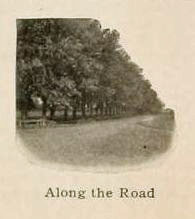 certain
to be very widely appreciated and speedily accepted by their competitors
in other part of the country. It is not too much to say that these are
the best road maps ever published. Their accuracy is assured for the
reason that the engineers of the Iowa Publishing Company, under the
personal supervision of M. Huebinger, C. E., of Des Moines, have an
established reputation in their profession second to none in the United
States.
certain
to be very widely appreciated and speedily accepted by their competitors
in other part of the country. It is not too much to say that these are
the best road maps ever published. Their accuracy is assured for the
reason that the engineers of the Iowa Publishing Company, under the
personal supervision of M. Huebinger, C. E., of Des Moines, have an
established reputation in their profession second to none in the United
States.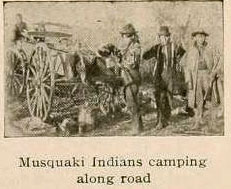 The
bottom dropped out of Iowa roads during the fall of 1909 as every Iowan
remembers, and the Glidden tour was in sight for advertisement of the
state for good or ill. This is why the work was undertaken. The River to
River Road Association, formed as a part of the state wide plans
formulated by delegates called together officially by Governor Carroll,
undertook the achievement. With an executive committeeman in each of
twelve counties in charge of the work in his county, things moved
quickly. Grades were built up, wet places drained and hundreds of drags
put in operation. This is how the work was carried out. Moreover, the
same methods and the same organization are keeping the highway in its
new condition, and, in fact, bettering it, from day to day.
The
bottom dropped out of Iowa roads during the fall of 1909 as every Iowan
remembers, and the Glidden tour was in sight for advertisement of the
state for good or ill. This is why the work was undertaken. The River to
River Road Association, formed as a part of the state wide plans
formulated by delegates called together officially by Governor Carroll,
undertook the achievement. With an executive committeeman in each of
twelve counties in charge of the work in his county, things moved
quickly. Grades were built up, wet places drained and hundreds of drags
put in operation. This is how the work was carried out. Moreover, the
same methods and the same organization are keeping the highway in its
new condition, and, in fact, bettering it, from day to day.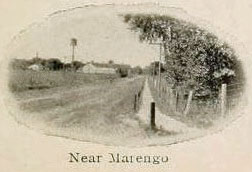


 Iowa’s
River to River Road is a dragged road from Davenport to Council Bluffs.
It crosses Iowa in almost a straight line from river to river along the
main route of all transcontinental travel. The road is 380 miles long.
It passes through Des Moines, capital of the state, a dozen bright,
hustling, little cities, ranging from 5,000 to 25,000 inhabitants and
some thirty small towns and villages. There are over 600 farm houses
fronting on the road and more than 1,500 that stand within one mile of
the road.
Iowa’s
River to River Road is a dragged road from Davenport to Council Bluffs.
It crosses Iowa in almost a straight line from river to river along the
main route of all transcontinental travel. The road is 380 miles long.
It passes through Des Moines, capital of the state, a dozen bright,
hustling, little cities, ranging from 5,000 to 25,000 inhabitants and
some thirty small towns and villages. There are over 600 farm houses
fronting on the road and more than 1,500 that stand within one mile of
the road. of
the twelve counties through which it passes. There is an executive
committeeman in each county who has full charge of everything pertaining
to the road in his territory. Headquarters are maintained with the
association secretary in charge in the office of The Des Moines Capital.
of
the twelve counties through which it passes. There is an executive
committeeman in each county who has full charge of everything pertaining
to the road in his territory. Headquarters are maintained with the
association secretary in charge in the office of The Des Moines Capital. …
remark of William Wiseman, former City Editor of The Capital, the good
roads editor learned of Col. Young’s suggestion of a River to River
Road. This was seized upon as the concrete thing to be accomplished and
to be made the basis of the entire general campaign. The River to River
Road idea and the plan for having the road improved and maintained by
the co-operation of the people living along the road was sprung. The
plan was based on the road officers of an unbroken line of townships
from one side of the state to the other, improving and maintaining the
section of the road lying inside their township borders. The idea caught
on. The general good roads campaign caught on also. March 8 and 9, in
response to a call issued by Governor Carroll, 2,000 delegates gathered
in Des Moines in a general state convention and in response to a call
from the good roads editor of The Capital 200 delegates from the twelve
River to River Road counties gathered in a caucus on the River to River
Road. There was a hot fight over rival routes, but in the end the River
to River Road Association was organized. Live men were secured in each
county as executive committeemen. These men organized their counties,
and finally set to work upon the actual improving of the highway. Grades
were built up, wet places drained and hundreds of road drags set to
work. Within a short time a large portion of the road was under road
dragging contracts, in which farmers living along the road, agreed to
drag the highway after every rain and receive the state drag law, the
sum of fifty cents per mile traveled by the drag.
…
remark of William Wiseman, former City Editor of The Capital, the good
roads editor learned of Col. Young’s suggestion of a River to River
Road. This was seized upon as the concrete thing to be accomplished and
to be made the basis of the entire general campaign. The River to River
Road idea and the plan for having the road improved and maintained by
the co-operation of the people living along the road was sprung. The
plan was based on the road officers of an unbroken line of townships
from one side of the state to the other, improving and maintaining the
section of the road lying inside their township borders. The idea caught
on. The general good roads campaign caught on also. March 8 and 9, in
response to a call issued by Governor Carroll, 2,000 delegates gathered
in Des Moines in a general state convention and in response to a call
from the good roads editor of The Capital 200 delegates from the twelve
River to River Road counties gathered in a caucus on the River to River
Road. There was a hot fight over rival routes, but in the end the River
to River Road Association was organized. Live men were secured in each
county as executive committeemen. These men organized their counties,
and finally set to work upon the actual improving of the highway. Grades
were built up, wet places drained and hundreds of road drags set to
work. Within a short time a large portion of the road was under road
dragging contracts, in which farmers living along the road, agreed to
drag the highway after every rain and receive the state drag law, the
sum of fifty cents per mile traveled by the drag. 
 At
Davenport, which sits so majestically upon its hills overlooking the
noble stream which laves its shores, one very naturally, and very
properly, goes to Rock Island arsenal on the government island opposits
the great city which is spreading out over so much of the eastern part
of Scott County. It is from this island that one of the most extensive
of the world’s railway systems takes its name and over its tracks,
crossing the island, the heavy traffic of transcontinental transport and
travel is daily shunted back and forth with the speed of lightning. From
car windows millions have eagerly caught glimpses of the beauties of
this reservation, which, in the midst of the scenes of peace, is devoted
to the purposes of war. Here is the greatest ordnance manufacturing
establishment in the United States, destined, if wars shall not cease,
to be one of the greatest in the world. Here, too, is one of the finest
natural parks in existence, golf links that have been pronounced the
peer of any in the world, and old buildings and cemeteries, Union and
Confederate, which give a spot naturally charming a high historical
interest. The length of this island can be traversed in an auto over a
government road of macadam that gives one an idea of what the River to
River road itself may be in the course of time, if the present interest
is not allowed to subside and the present organization for improvement
is sedulously maintained. The arsenal road is road perfection, nothing
less.
At
Davenport, which sits so majestically upon its hills overlooking the
noble stream which laves its shores, one very naturally, and very
properly, goes to Rock Island arsenal on the government island opposits
the great city which is spreading out over so much of the eastern part
of Scott County. It is from this island that one of the most extensive
of the world’s railway systems takes its name and over its tracks,
crossing the island, the heavy traffic of transcontinental transport and
travel is daily shunted back and forth with the speed of lightning. From
car windows millions have eagerly caught glimpses of the beauties of
this reservation, which, in the midst of the scenes of peace, is devoted
to the purposes of war. Here is the greatest ordnance manufacturing
establishment in the United States, destined, if wars shall not cease,
to be one of the greatest in the world. Here, too, is one of the finest
natural parks in existence, golf links that have been pronounced the
peer of any in the world, and old buildings and cemeteries, Union and
Confederate, which give a spot naturally charming a high historical
interest. The length of this island can be traversed in an auto over a
government road of macadam that gives one an idea of what the River to
River road itself may be in the course of time, if the present interest
is not allowed to subside and the present organization for improvement
is sedulously maintained. The arsenal road is road perfection, nothing
less. tears,
one honks down the asphalted streets of Davenport, assuredly one of the
most beautiful and one of the most interesting of Midwestern American
cities. Here, counting the cities of Rock Island and Moline, which find
their metropolitan center on the Iowa side, is a community very
compactly built, covering in fact hardly more than half of the area of
the city of Des Moines, and yet possessing a population of not less than
125,000 souls. The growth of each decade of late has been about 25,000
with a decided tendency to acceleration as the aggregate increases. It
is perfectly certain that there is to be at this point on the banks of
the Mississippi a two-state city of not less than a quarter of a million
people in the course of another generation. Always an important
distributing point for eastern Iowa and western Illinois, Davenport has
been growing great at the expense of its neighbors in the manufacturing
and wholesaling lines and has easily been able to hold its own in all
fields in …
tears,
one honks down the asphalted streets of Davenport, assuredly one of the
most beautiful and one of the most interesting of Midwestern American
cities. Here, counting the cities of Rock Island and Moline, which find
their metropolitan center on the Iowa side, is a community very
compactly built, covering in fact hardly more than half of the area of
the city of Des Moines, and yet possessing a population of not less than
125,000 souls. The growth of each decade of late has been about 25,000
with a decided tendency to acceleration as the aggregate increases. It
is perfectly certain that there is to be at this point on the banks of
the Mississippi a two-state city of not less than a quarter of a million
people in the course of another generation. Always an important
distributing point for eastern Iowa and western Illinois, Davenport has
been growing great at the expense of its neighbors in the manufacturing
and wholesaling lines and has easily been able to hold its own in all
fields in …  …
the face of keen competition from Chicago, less than 200 miles away.
Through the activity and well directed efforts of its business men in
the associated capacity, it has cultivated a steadily enlarging field of
trade, until, in these days, wherever one goes in Iowa one meets the
Davenport traveling man carrying sample cases for Davenport houses and
extremely proud of it. Love of his city is the striking characteristic
of the Davenporter, and when one has seen his city and its surroundings
as one may easily do in an auto any fine day, one does not wonder at all
that he feels that way about it. Up at Bettendorf, which is an adjacent
suburb, there is one of the mammoth factories of the country in process
of erection and at the same time in operation day and night making steel
cars for the railways. It would take a book larger than this one merely
to enumerate the industries of Davenport. Besides it is more pleasant to
visit the parks and traverse the boulevards.
…
the face of keen competition from Chicago, less than 200 miles away.
Through the activity and well directed efforts of its business men in
the associated capacity, it has cultivated a steadily enlarging field of
trade, until, in these days, wherever one goes in Iowa one meets the
Davenport traveling man carrying sample cases for Davenport houses and
extremely proud of it. Love of his city is the striking characteristic
of the Davenporter, and when one has seen his city and its surroundings
as one may easily do in an auto any fine day, one does not wonder at all
that he feels that way about it. Up at Bettendorf, which is an adjacent
suburb, there is one of the mammoth factories of the country in process
of erection and at the same time in operation day and night making steel
cars for the railways. It would take a book larger than this one merely
to enumerate the industries of Davenport. Besides it is more pleasant to
visit the parks and traverse the boulevards. 
 Durant
Durant
 The
environments here are of the best. In this connection we take pride in
our Y.M.C.A. home, costing over $25,000, our public library, the finely
equipped university library and museum, our city parks, one of which
covers over eighty acres and is a garden spot supplied with attractions
for young people.
The
environments here are of the best. In this connection we take pride in
our Y.M.C.A. home, costing over $25,000, our public library, the finely
equipped university library and museum, our city parks, one of which
covers over eighty acres and is a garden spot supplied with attractions
for young people. …
it to any city twice the size of Iowa City and with a membership of 250
is actively engaged in promoting the interests of the city and its
citizens. That Iowa City has a great future is evidenced by the
activities in interurbans at this time, now having a line to Cedar
Rapids on the north, two more interurbans are to be built. One to
Davenport on the east and one to Otumwa on the southwest. A street car
system will be built before snow flies in the autumn of 1910.
…
it to any city twice the size of Iowa City and with a membership of 250
is actively engaged in promoting the interests of the city and its
citizens. That Iowa City has a great future is evidenced by the
activities in interurbans at this time, now having a line to Cedar
Rapids on the north, two more interurbans are to be built. One to
Davenport on the east and one to Otumwa on the southwest. A street car
system will be built before snow flies in the autumn of 1910. has
an Elks club building just recently completed costing over $35,000 and
is complete in every particular. The Country Club and golf links along
the beautiful Iowa river affords an excellent outing during the summer
months.
has
an Elks club building just recently completed costing over $35,000 and
is complete in every particular. The Country Club and golf links along
the beautiful Iowa river affords an excellent outing during the summer
months.

 In
1842 Mons. Cabet’s book on communism, and imaginary utopian dream called
“The Voyage and Adventures of Lord Carisdal in Icaria,” seemed to
stimulate the society to a new movement in search of a new and broader
field and greater liberty of action, with less of the antagonism
experienced in the old country. So in 1842 four men were selected to
visit America and look up a new location. They reached this country
toward the last of October, 1842, and first examined lands near Lake
Chautauqua, in western New York, but were not suited. They then examined
lands near Buffalo, soon to be vacated by the Seneca Indians, and
finally purchased 5,000 acres at $10.50 an acre. Members of the society
to the number of fifty soon came over and in May, 1843, a village was
laid out and named Ebenezer. Later two other villages were platted and
called Upper and Lower Ebenezer, the first one being then called Middle
Ebenezer. A large meeting house was built, also school houses, as well
as dwellings and a saw mill. By the end of 1843 the community numbered
350 persons. Some trouble of an annoying nature was had with the
Indians, who were slow to vacate the lands, in time. In 1844 members had
come over from the old country until the membership reached 800. In
February, 1845, the society was incorporated; saw mills, grist mills and
woolen mills were built and additional land purchased until they were
owners of 8,000 acres.
In
1842 Mons. Cabet’s book on communism, and imaginary utopian dream called
“The Voyage and Adventures of Lord Carisdal in Icaria,” seemed to
stimulate the society to a new movement in search of a new and broader
field and greater liberty of action, with less of the antagonism
experienced in the old country. So in 1842 four men were selected to
visit America and look up a new location. They reached this country
toward the last of October, 1842, and first examined lands near Lake
Chautauqua, in western New York, but were not suited. They then examined
lands near Buffalo, soon to be vacated by the Seneca Indians, and
finally purchased 5,000 acres at $10.50 an acre. Members of the society
to the number of fifty soon came over and in May, 1843, a village was
laid out and named Ebenezer. Later two other villages were platted and
called Upper and Lower Ebenezer, the first one being then called Middle
Ebenezer. A large meeting house was built, also school houses, as well
as dwellings and a saw mill. By the end of 1843 the community numbered
350 persons. Some trouble of an annoying nature was had with the
Indians, who were slow to vacate the lands, in time. In 1844 members had
come over from the old country until the membership reached 800. In
February, 1845, the society was incorporated; saw mills, grist mills and
woolen mills were built and additional land purchased until they were
owners of 8,000 acres. The
Amana Society is regularly incorporated under the laws of the state. Its
principal object is defined to be promotion of the temporal and
spiritual welfare and happiness of its members; and its principal
business to acquire real and personal property, to carry on agricultural
and mechanical pursuits, to build villages, churches, schools,
factories, etc. The legislative management of the society is in the
hands of thirteen trustees elected annually. The executive department
consists of one director, one vice-director and one secretary elected
annually by the trustees.
The
Amana Society is regularly incorporated under the laws of the state. Its
principal object is defined to be promotion of the temporal and
spiritual welfare and happiness of its members; and its principal
business to acquire real and personal property, to carry on agricultural
and mechanical pursuits, to build villages, churches, schools,
factories, etc. The legislative management of the society is in the
hands of thirteen trustees elected annually. The executive department
consists of one director, one vice-director and one secretary elected
annually by the trustees. Marengo
Marengo Ladora
Ladora
 A
New England town in the heart of Iowa, the little city of Grinnell
stands unique among the communities of the state. Its streets, arched
over with trees, its well-kept green lawns, no less than the attitude of
its people toward moral and religious questions, help to convey the
impression of New England.
A
New England town in the heart of Iowa, the little city of Grinnell
stands unique among the communities of the state. Its streets, arched
over with trees, its well-kept green lawns, no less than the attitude of
its people toward moral and religious questions, help to convey the
impression of New England. In
1882, the historic Grinnell cyclone swept them both, but both rose
stronger than ever before from their ruins. The cyclone was a blessing
in disguise for Grinnell as was the fire which destroyed the business
section a few years later, for as a result Grinnell has more modern
business blocks than are usually found in a town of this size.
In
1882, the historic Grinnell cyclone swept them both, but both rose
stronger than ever before from their ruins. The cyclone was a blessing
in disguise for Grinnell as was the fire which destroyed the business
section a few years later, for as a result Grinnell has more modern
business blocks than are usually found in a town of this size. Newton
Newton
 which
connects with the Great Western, and is on the Fort Dodge, Des Moines
and Southern Railway.
which
connects with the Great Western, and is on the Fort Dodge, Des Moines
and Southern Railway. …
car line, and three plants which bottle its famous water, more than 400
carloads are sent to all parts of the United States annually.
…
car line, and three plants which bottle its famous water, more than 400
carloads are sent to all parts of the United States annually. skirting
the Chasaqua River.
skirting
the Chasaqua River. Mitchellville
Mitchellville
 Des
Moines, the capital of the state and the chief commercial city of
central Iowa, is situated at the junction of the Des Moines and Raccoon
rivers and is on the Chicago-Omaha line of the Rock Island railway, and
the Chicago-Kansas City line of the Chicago Great Western railroad.
Besides these two main lines of road it is the terminus of important
branches of the Milwaukee, Wabash, Burlington, Northwestern and other
systems. It is also the center of the only extensive system of
interurban railways between the Mississippi river and the Rockies. In
the last five years the city, now with a population of about 100,000,
has been marvelously improved and beautified until
Des
Moines, the capital of the state and the chief commercial city of
central Iowa, is situated at the junction of the Des Moines and Raccoon
rivers and is on the Chicago-Omaha line of the Rock Island railway, and
the Chicago-Kansas City line of the Chicago Great Western railroad.
Besides these two main lines of road it is the terminus of important
branches of the Milwaukee, Wabash, Burlington, Northwestern and other
systems. It is also the center of the only extensive system of
interurban railways between the Mississippi river and the Rockies. In
the last five years the city, now with a population of about 100,000,
has been marvelously improved and beautified until
 it
is now recognized as being one of the most attractive and modern of all
the cities in the United States. Many large buildings of artistic design
have been erected and this, with a general remodeling of interiors and
exteriors in the downtown district, together with a most comprehensive
scheme of lighting the streets by means of the artistic electroliers,
gives the town a metropolitan aspect. The hotel accommodations are ample
and good restaurants are many.
it
is now recognized as being one of the most attractive and modern of all
the cities in the United States. Many large buildings of artistic design
have been erected and this, with a general remodeling of interiors and
exteriors in the downtown district, together with a most comprehensive
scheme of lighting the streets by means of the artistic electroliers,
gives the town a metropolitan aspect. The hotel accommodations are ample
and good restaurants are many. Garages
are legion and the fact that all seem to be doing a lively business
indicates that this is the automobile center of the middle part of the
state. There are a number of fine drives through the city, which covers
over fifty square miles of area. The park system is on a magnificent
scale in preparation for the needs of a city of half a million people.
Garages
are legion and the fact that all seem to be doing a lively business
indicates that this is the automobile center of the middle part of the
state. There are a number of fine drives through the city, which covers
over fifty square miles of area. The park system is on a magnificent
scale in preparation for the needs of a city of half a million people. the
town is often the cause of remark by strangers. Many thousands of
dollars are spent annually in advertising Des Moines as the “city of
certainties” and such mediums as the Saturday Evening Post are freely
used for full-page displays. The Greater Des Moines Committee is the
organization that has this remarkable publicity campaign in charge and
it is said that results of a substantial nature are already in sight.
the
town is often the cause of remark by strangers. Many thousands of
dollars are spent annually in advertising Des Moines as the “city of
certainties” and such mediums as the Saturday Evening Post are freely
used for full-page displays. The Greater Des Moines Committee is the
organization that has this remarkable publicity campaign in charge and
it is said that results of a substantial nature are already in sight.
 Among
the institutions that go to make Adel up-to-date, of a more or less
public nature, are the following: Unsurpassed public schools, with
eleven teachers; four churches, the Methodist, Presbyterian, Christian
and Adventist; two immense brick and tile factories, large flouring
mill, bonnet and glove factory, Dr. Scott’s Sanitarium, printing press
factory, cigar factory, elegant modern opera house. Besides the above,
there is the full complement of professional and mercantile
institutions, shops, etc., operated by wide-awake business men and
women. The fraternal and social side is well represented by lodges of
the Masons, Odd Fellows, Knights of Pythias, A.O.U.W. and the Daughters
of Rebekah orders, the G.A.R., the W. R.C., several social and literary
clubs, etc. Adel numbers among its citizens many first-class musicians,
a band is maintained and gives street concerts during the summer, and in
vocal music the town is in the front rank. Athletics are given proper
attention, lawn tennis, baseball, football, rowing, etc., receiving a
place in the program of amusements that entertain the resident and the
visitor in a manner each enjoys.
Among
the institutions that go to make Adel up-to-date, of a more or less
public nature, are the following: Unsurpassed public schools, with
eleven teachers; four churches, the Methodist, Presbyterian, Christian
and Adventist; two immense brick and tile factories, large flouring
mill, bonnet and glove factory, Dr. Scott’s Sanitarium, printing press
factory, cigar factory, elegant modern opera house. Besides the above,
there is the full complement of professional and mercantile
institutions, shops, etc., operated by wide-awake business men and
women. The fraternal and social side is well represented by lodges of
the Masons, Odd Fellows, Knights of Pythias, A.O.U.W. and the Daughters
of Rebekah orders, the G.A.R., the W. R.C., several social and literary
clubs, etc. Adel numbers among its citizens many first-class musicians,
a band is maintained and gives street concerts during the summer, and in
vocal music the town is in the front rank. Athletics are given proper
attention, lawn tennis, baseball, football, rowing, etc., receiving a
place in the program of amusements that entertain the resident and the
visitor in a manner each enjoys. The
pioneers of Iowa parted company with the railroad at Chicago, and
plodded their way in prairie schooners across trackless prairies,
following the line of least resistance, making first settlements by the
wayside, and it is interesting to note that the tide of emigration, the
great western trail of civilization, closely followed the present River
to River Road across Guthrie county and through Guthrie Center. The site
of the very first cabin built in Guthrie county is to be seen on the
River to River Road, and is marked by an appropriate signboard. The
overland stage route from Des Moines to Council Bluffs likewise followed
Nature’s highway for many miles through Guthrie county, closely
coinciding with the present-day River to River Road, and one of the old
stage barns, with its dim and battered signboard, still adorns the
wayside, a grim reminder of by-gone days. It has been said that the
finger of Divine Love traced this natural highway through our rolling
prairies and gently sloping valleys, and today a thorough organization
of wide-awake farmers in Guthrie county is taking advantage of what
Nature has done for them, and aspire to make this section of the River
to River Road the best and most attractive piece of dirt highway in the
entire state.
The
pioneers of Iowa parted company with the railroad at Chicago, and
plodded their way in prairie schooners across trackless prairies,
following the line of least resistance, making first settlements by the
wayside, and it is interesting to note that the tide of emigration, the
great western trail of civilization, closely followed the present River
to River Road across Guthrie county and through Guthrie Center. The site
of the very first cabin built in Guthrie county is to be seen on the
River to River Road, and is marked by an appropriate signboard. The
overland stage route from Des Moines to Council Bluffs likewise followed
Nature’s highway for many miles through Guthrie county, closely
coinciding with the present-day River to River Road, and one of the old
stage barns, with its dim and battered signboard, still adorns the
wayside, a grim reminder of by-gone days. It has been said that the
finger of Divine Love traced this natural highway through our rolling
prairies and gently sloping valleys, and today a thorough organization
of wide-awake farmers in Guthrie county is taking advantage of what
Nature has done for them, and aspire to make this section of the River
to River Road the best and most attractive piece of dirt highway in the
entire state.
 The
county of Guthrie stands among the foremost in general agriculture and
stock raising resources, fully meeting all expectations in those lines;
but, what is more important to the casual traveler, is the scenic beauty
which meets the eye at every turn of the road.
The
county of Guthrie stands among the foremost in general agriculture and
stock raising resources, fully meeting all expectations in those lines;
but, what is more important to the casual traveler, is the scenic beauty
which meets the eye at every turn of the road. Amid
these beautiful scenes, in the South ‘Coon Valley, is Guthrie Center,
county seat and county metropolis of Guthrie county, drawing trade from
a rich and vast farming territory. Its business men are alive to the
demands of the times, carrying splendid stocks of goods in all lines. It
has water works, an electric light plant, two splendid parks, good
hotels, creamery, flouring mills, fore company, a military band of more
than statewide reputation, and no end of churches and civic societies.
It is adorned with
Amid
these beautiful scenes, in the South ‘Coon Valley, is Guthrie Center,
county seat and county metropolis of Guthrie county, drawing trade from
a rich and vast farming territory. Its business men are alive to the
demands of the times, carrying splendid stocks of goods in all lines. It
has water works, an electric light plant, two splendid parks, good
hotels, creamery, flouring mills, fore company, a military band of more
than statewide reputation, and no end of churches and civic societies.
It is adorned with
 beautiful
tree-embowered homes, and is graced by buildings that would do credit to
a much larger place. It has a live Commercial Club and an Automobile
Association affiliated with the state and national associations, which
in membership is out-ranked by only two other automobile associations in
Iowa. There are three garages, one of them just completed, being fire
proof with machine in connection, adjoining electric light plant.
beautiful
tree-embowered homes, and is graced by buildings that would do credit to
a much larger place. It has a live Commercial Club and an Automobile
Association affiliated with the state and national associations, which
in membership is out-ranked by only two other automobile associations in
Iowa. There are three garages, one of them just completed, being fire
proof with machine in connection, adjoining electric light plant. welcome
the tourist receives at Avoca. A public band concert is held every
Wednesday evening and the traveler is indeed fortunate if one is in
Avoca on those occasions.
welcome
the tourist receives at Avoca. A public band concert is held every
Wednesday evening and the traveler is indeed fortunate if one is in
Avoca on those occasions. Neola
Neola
 prosperity
is, therefore, very generally diffused. The booster spirit is strong and
there is no question that the city’s future is to be very bright. It is
said that Muscatine has more telephones for its population than any
other city in the world. The tourist will find everything he can desire
in the way of garage accommodations and supplies in this city, and in
its surroundings will discover one of the most picturesque scenes of
river and wooded hills anywhere in the West. Near Muscatine are the
principal gardens of the Heinz company, the makers of so many varieties
of pickles and preserves. The soil hereabouts is peculiarly adapted to
the successful culture of vegetables and small fruits and the region is
famous all over the country for its melons. While it is off the River to
River Road, a branch runs from West Liberty to Muscatine and from
Muscatine to Davenport.
prosperity
is, therefore, very generally diffused. The booster spirit is strong and
there is no question that the city’s future is to be very bright. It is
said that Muscatine has more telephones for its population than any
other city in the world. The tourist will find everything he can desire
in the way of garage accommodations and supplies in this city, and in
its surroundings will discover one of the most picturesque scenes of
river and wooded hills anywhere in the West. Near Muscatine are the
principal gardens of the Heinz company, the makers of so many varieties
of pickles and preserves. The soil hereabouts is peculiarly adapted to
the successful culture of vegetables and small fruits and the region is
famous all over the country for its melons. While it is off the River to
River Road, a branch runs from West Liberty to Muscatine and from
Muscatine to Davenport.